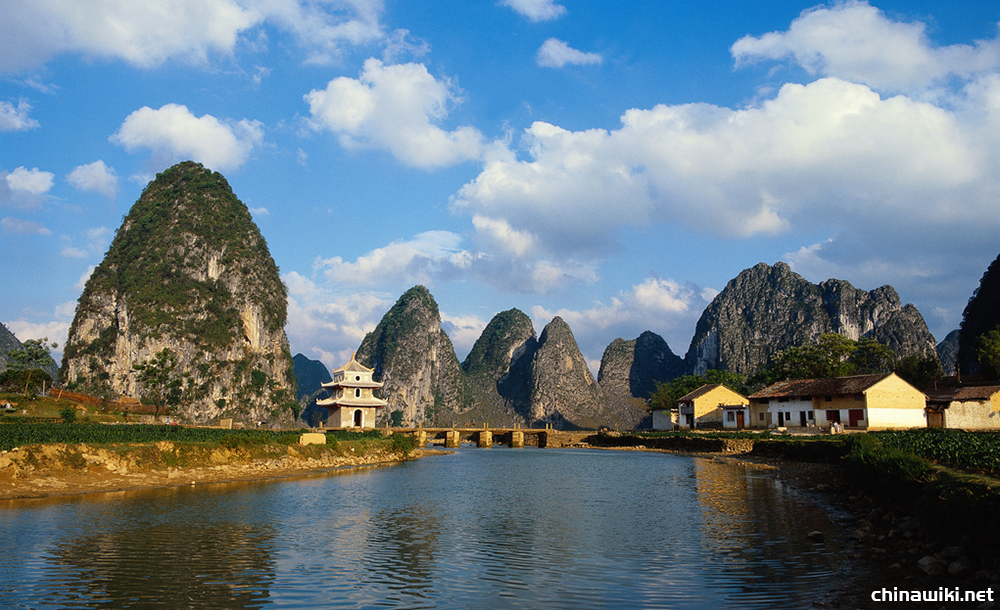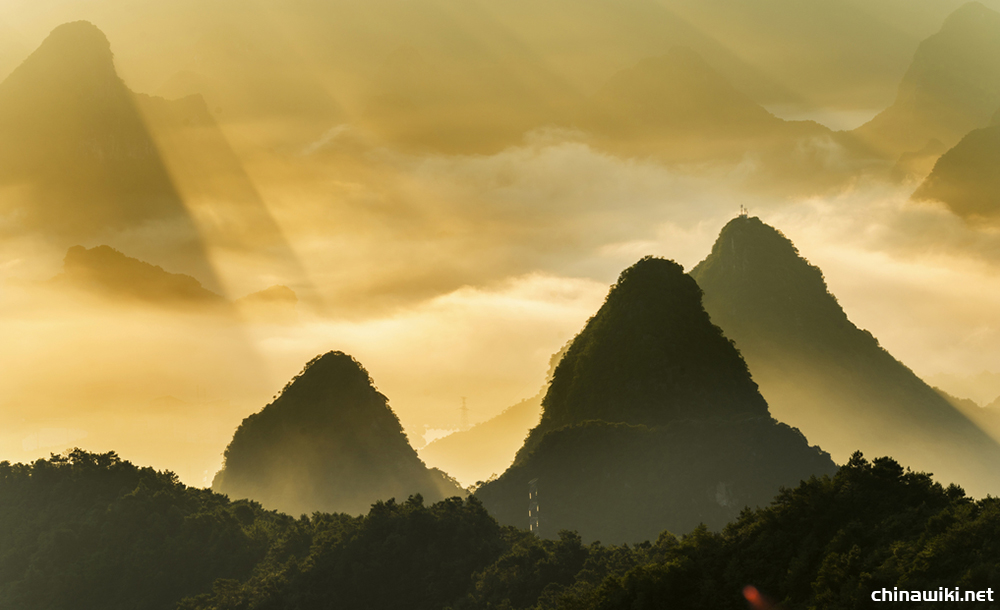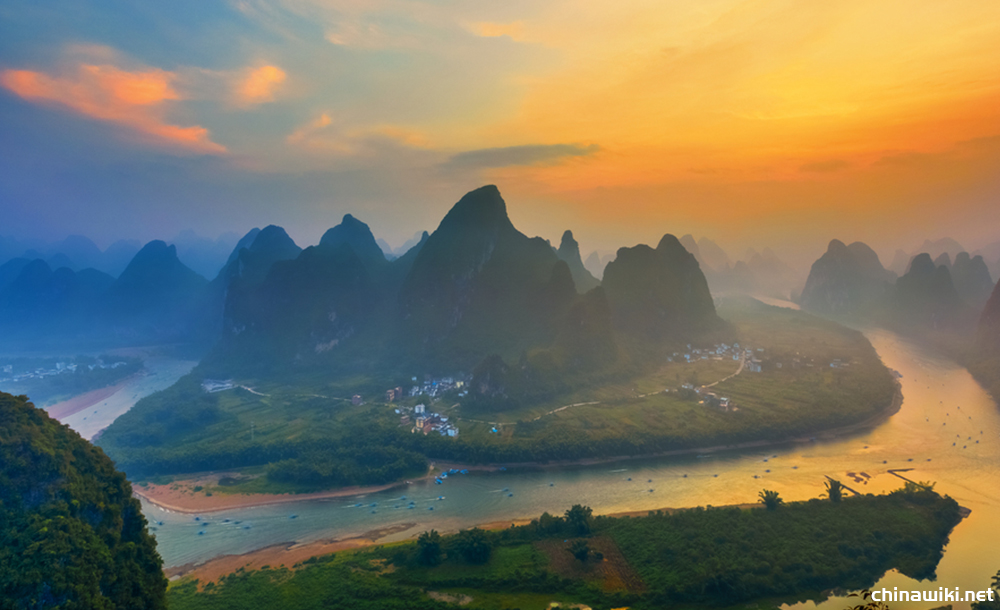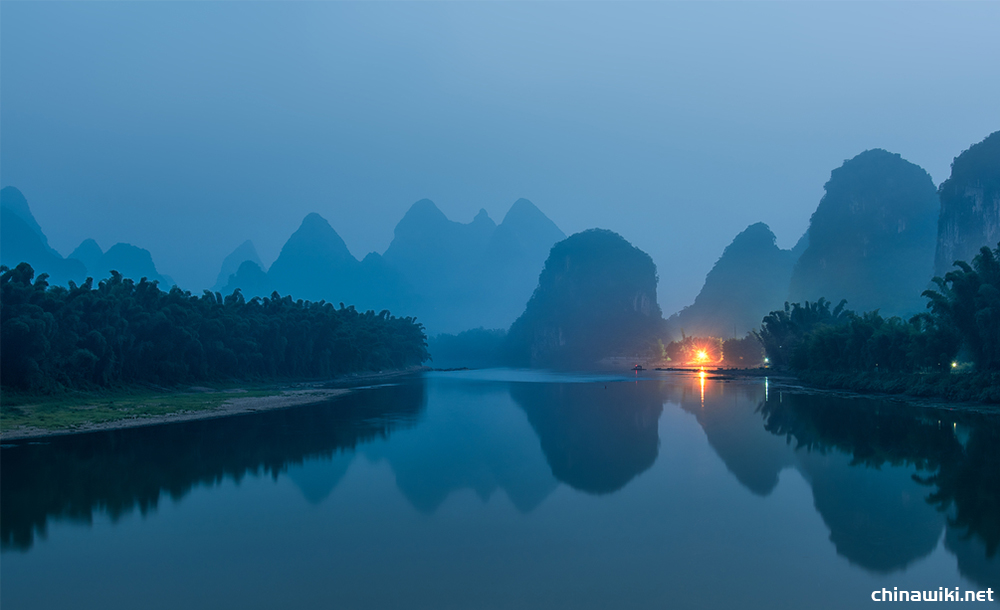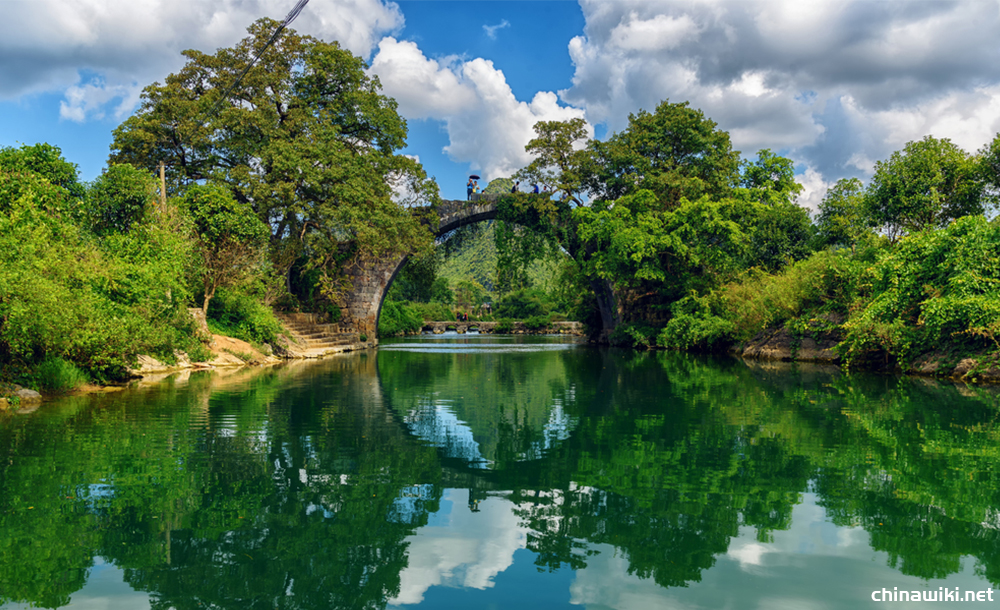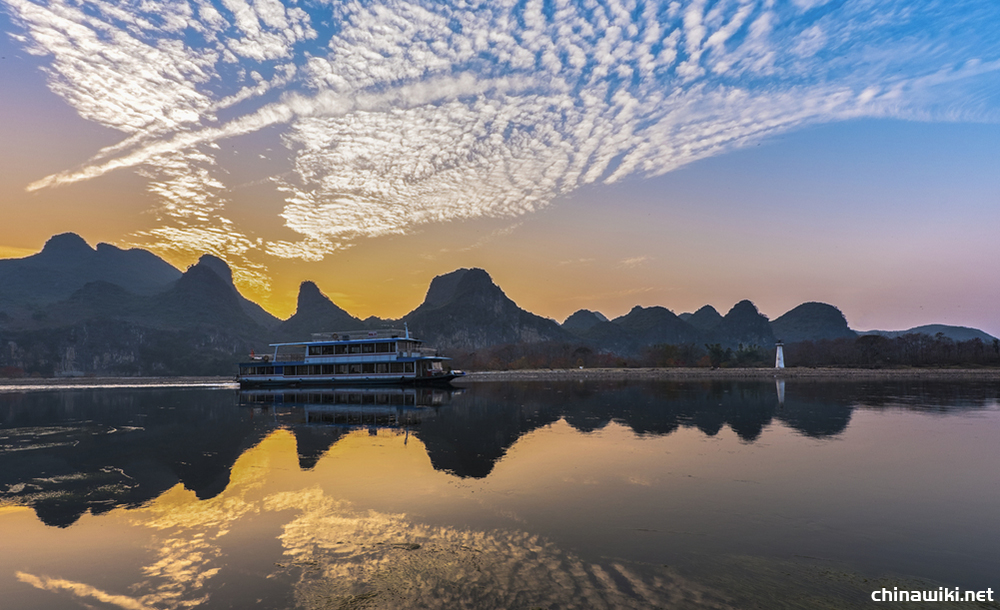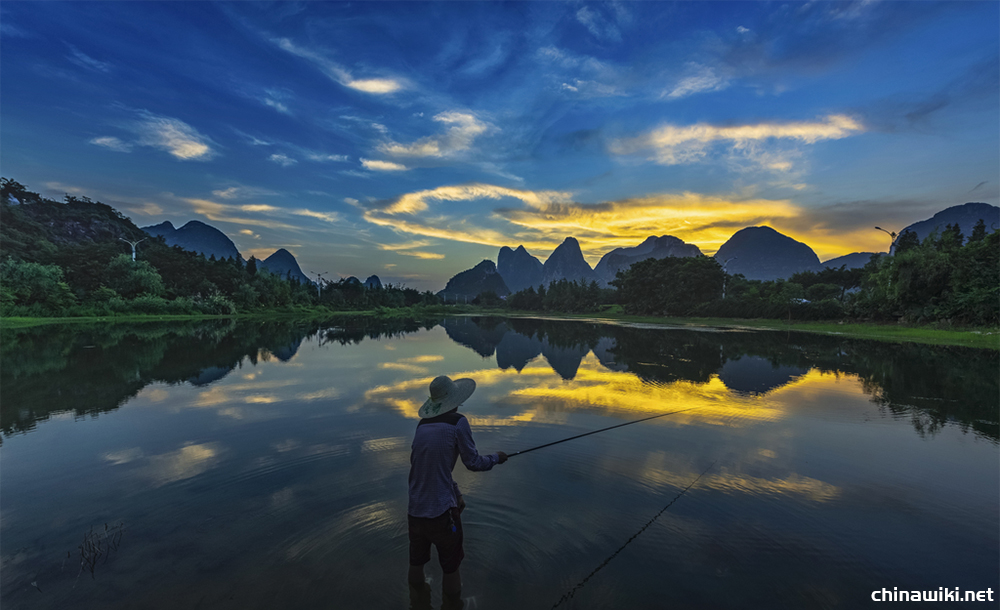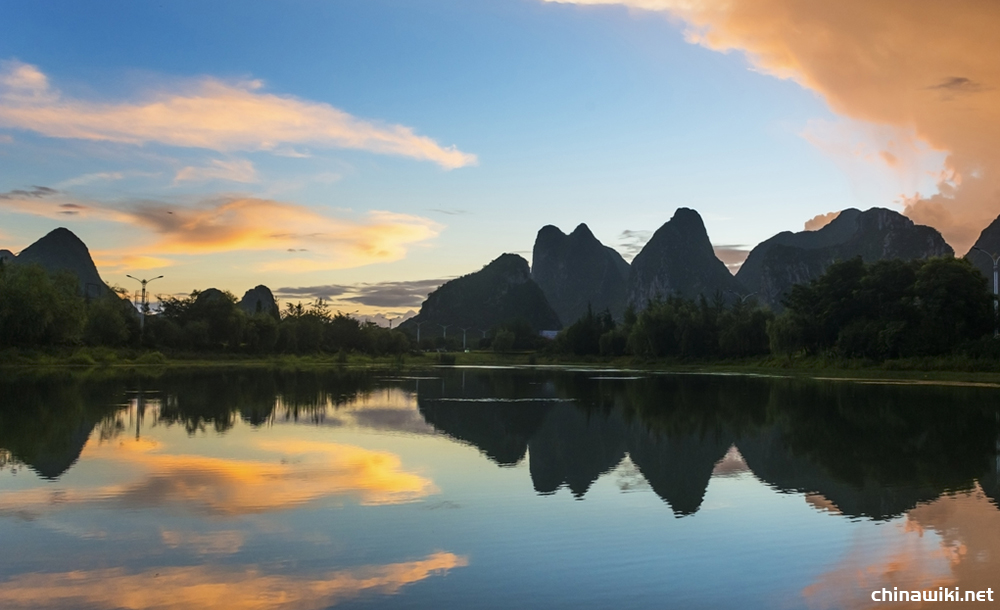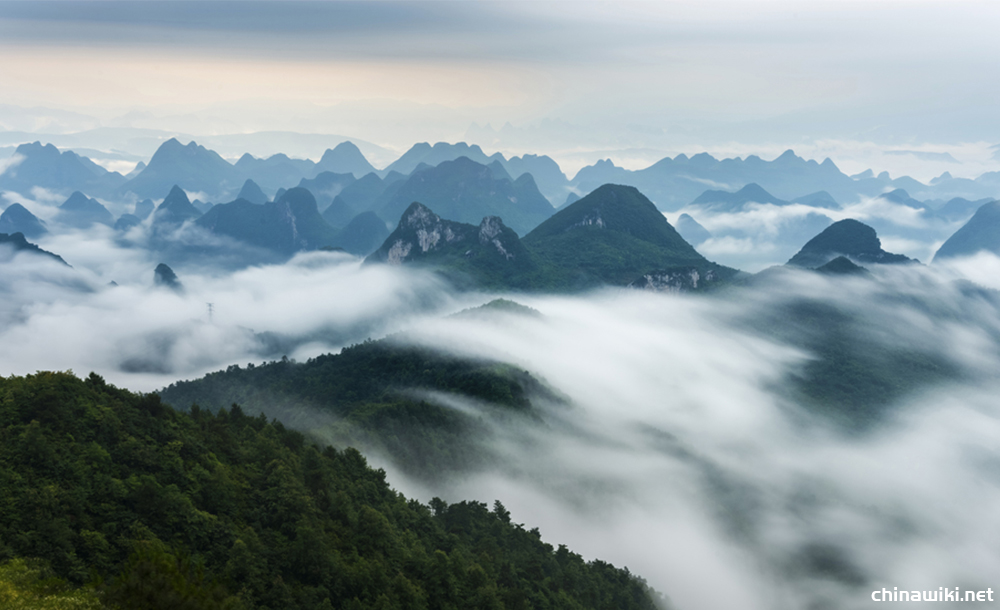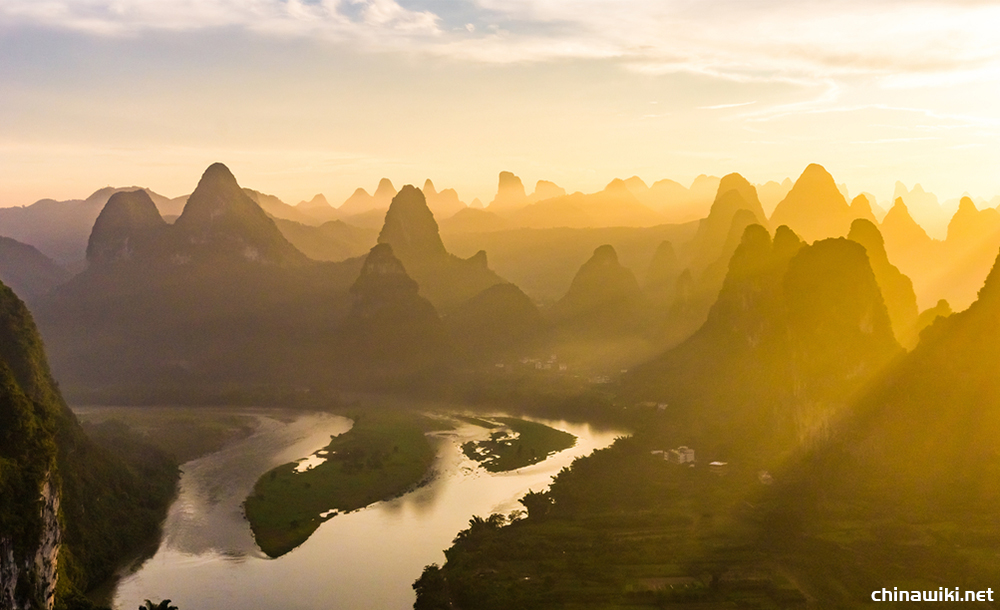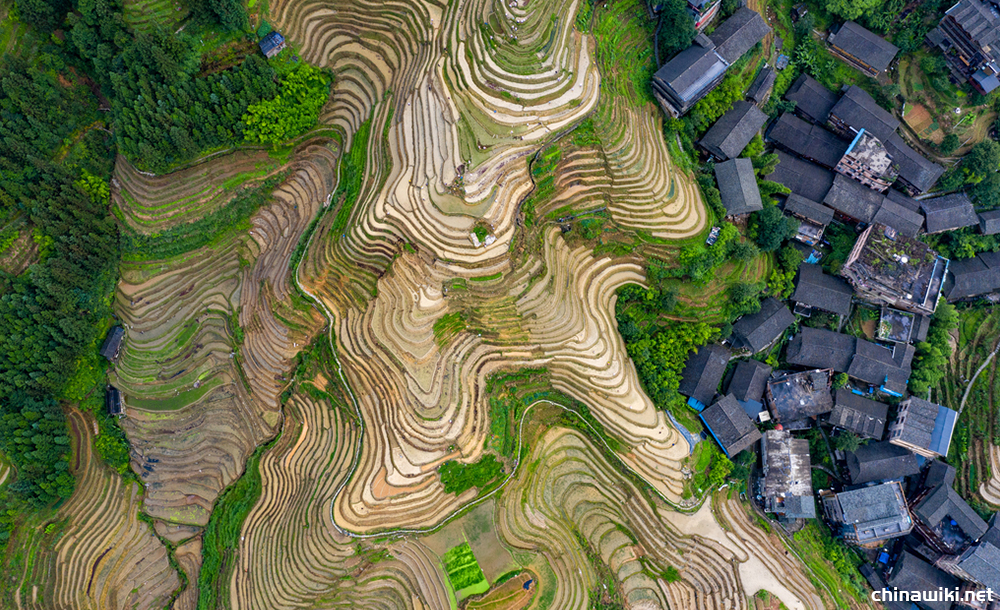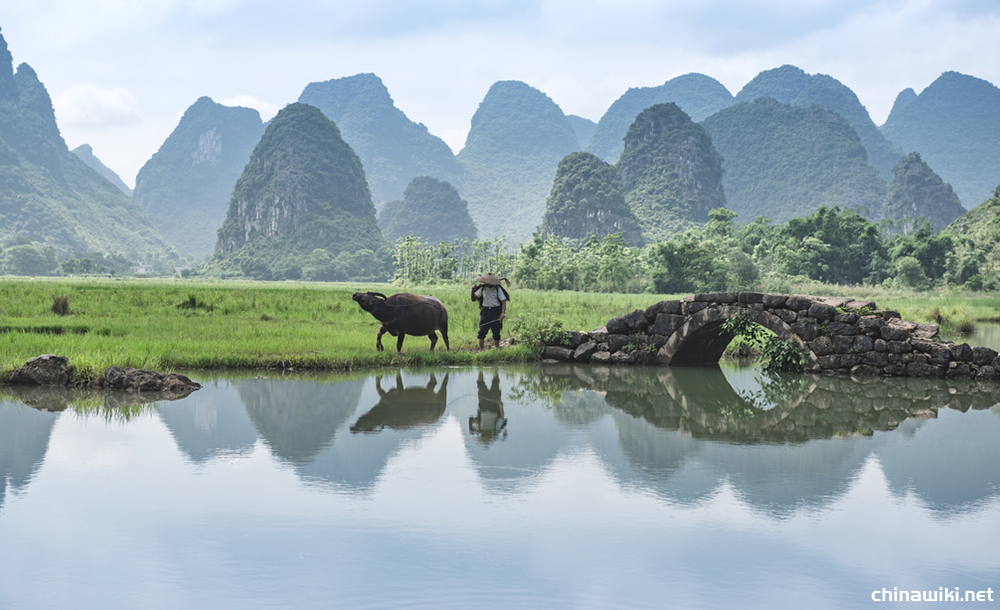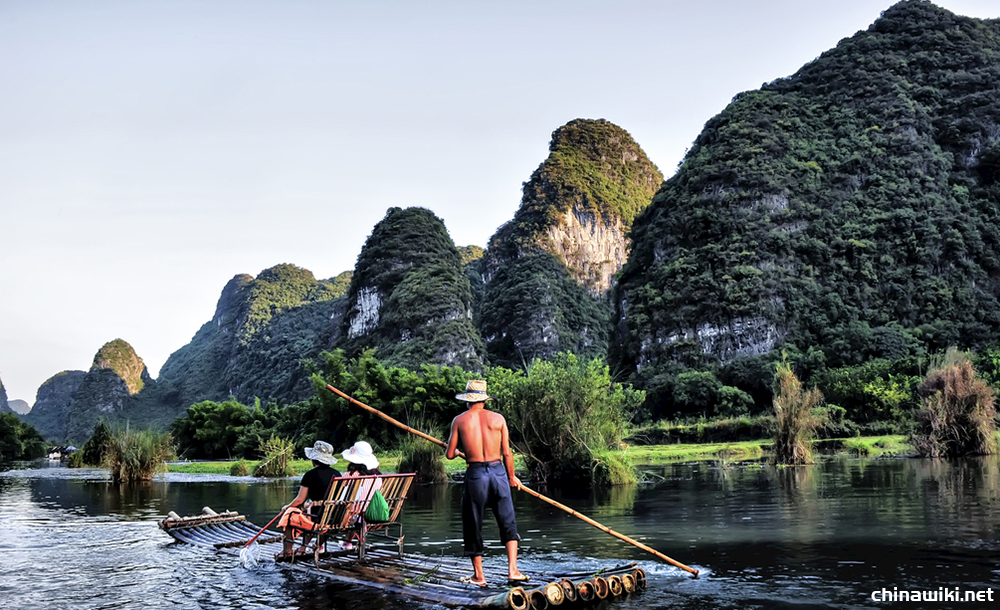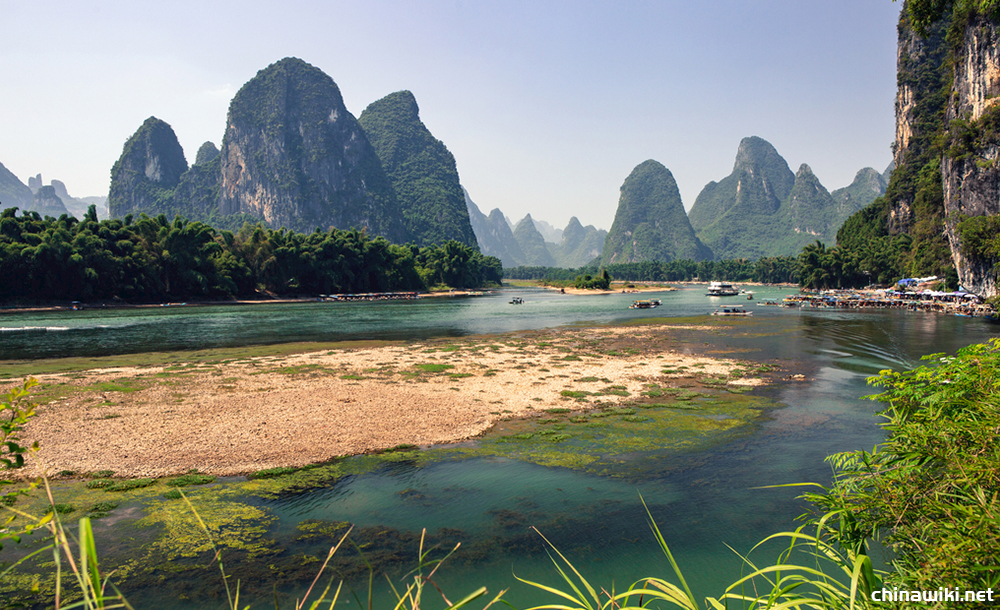Guilin
Guilin, or Guilin, is a world-famous scenic city, a million year wisdom holy land, an important national high-tech industrial base and an old industrial base in China. It is an international tourism city that has been opened to the outside world, a leading area for national tourism innovation and development and an integrated transportation hub for international tourism approved by the State Council. By 2019, it has six districts, 10 counties and 1 county-level city under its jurisdiction The total area is 27800 square kilometers, and the built-up area is 162 square kilometers. According to the seventh census, as of 0:00 on November 1, 2020, Guilin has a permanent population of 4931137.
Guilin is located in South China and the south end of Hunan Guangxi corridor. It is the residence of Guilin joint service support center of the Central Military Commission, national sustainable development agenda innovation demonstration area, and China tourism industry wind vane. The International Forum on tourism trends and prospects of the United Nations World Tourism Organization / Asia Pacific Tourism Association is held for a long time, It is an important node city for the strategic intersection of Pan Pearl River Delta economic zone and ASEAN Free Trade Zone, and also an international tourist attraction dominated by new industries.
Guilin is one of the first national historical and cultural cities. After the unification of Lingnan, the emperor of Qinshihuang belongs to Guilin county. In 1201, Wang Zhenggong, a famous poet, wrote a poem "Guilin mountains and rivers are the top priority". The culture of zengpiwan is one of the cultural sources of the process of pluralistic integration in China before history. The pottery rudiments discovered in zengpiwan fill the gap of the origin of the world pottery, and it is one of the important origins of Chinese pottery technology. Guilin is an important university cluster in Guangxi. It has 16 universities, including Guangxi Normal University, Guilin University of electronic technology, Guilin University of technology, Guilin Medical College, army special combat college, etc. ESI subjects were selected into 4 universities, ranking first in Guangxi and 32 subjects in the fourth round of subject evaluation.
In March 2021, the foreign ministers' talks between China and Russia were held in Guilin; On the afternoon of April 26th, general secretary Xi Jinping came to the city of Elephant Trunk Hill Park in Guilin to investigate and investigate: we must care for Guilin Scenery and strive to build world-class tourist city and livable city.
| Chinese name | Guilin |
| Foreign name | Guilin |
| alias | Bagui, Guizhou, Shi'an, Jingjiang |
| area number | four hundred and fifty thousand and three hundred |
| Category of Administrative Region | Prefecture level city |
| Region | Guangxi Zhuang Autonomous Region, China |
| geographical position | South China, Northeast Guangxi |
| the measure of area | 27800km ² |
| Jurisdiction area | 6 municipal districts, 1 county-level city, 8 counties and 2 autonomous counties |
| Government residence | 69 Xicheng Middle Road, Lingui District |
| Area Code | 0773 |
| zip code | five hundred and forty-one thousand |
| climatic conditions | Subtropical monsoon climate |
| Famous scenic spot | Lijiang River, Lingqu, Xiangbi mountain, dongxixiang, jingjiangwangcheng, Huixian wetland, etc |
| airport | guilin liangjiang international airport |
| train station | Guilin station, Guilin north station, Guilin North integrated passenger transport hub, Guilin west station |
| License plate code | GUI C |
| Gross Regional Product | 213041 billion yuan (2020) |
| dialect | Southwest Mandarin Guilin dialect |
| GDP per capita | 41294 yuan (2019) |
| Famous universities | Guangxi Normal University, Guilin University of Electronic Science and technology, Guilin University of Technology |
| Current leader | Zhou Jiabin (secretary of the municipal Party committee), Li Chu (Deputy Secretary of the municipal Party committee, mayor) |
| population | 4931137 (permanent resident at 0:00 on November 1, 2020) |
Guilin Historical evolution
The origin of place names and the origin of culture
The name of Guilin was first found in the mountain and sea classics in Warring States period. The book of the south of the sea has the records of eight trees in Guilin, which are in the east of Fanyu“ Guilin was named after Qin Dynasty, and Guilin county was famous for its abundant jade and GUI.
Guilin is a human wisdom holy land with a history of ten thousand years. The culture of Zengyi rock is one of the cultural sources of the multi integration process of prehistoric China. It represents an optimal adaptation mode of ancient human in subtropical and tropical areas from 12000 to 7000 years ago, and carries important historical information of prehistoric cultural exchange and development between China and Southeast Asia.
Guangxi has been one of the 18 provinces in the Han Dynasty of China since ancient times. Guilin is the capital of Guangxi Province. Since Guangxi was founded for 800 years, Guilin has been the political, cultural, economic and military center of Guangxi. Guilin was the capital of the national model Province during the period of the new Guangxi system administration of the Republic of China. During the Anti Japanese War, Guilin was regarded as the cultural city as the cultural center of the Anti Japanese war.
Xia Shang period
In Xia, Shang and Zhou dynasties, this was the residence of "Baiyue people".
In the spring and Autumn period and Warring States period, Lingnan was called the place of Baiyue, and Guilin was a part of Baiyue.
Qin and Han Dynasties
In 214 BC, the Qin Dynasty conquered Baiyue, and set Guilin County, Nanhai county and Xiangjun in the south of the Lingnan.
In 214 BC, after the emperor of Qin Shihuang dug Lingqu and communicated the two rivers of Hunan and Li, Guilin became a key town of "connecting the sea area in the South and reaching the Central Plains in the north". After the unification of the Lingnan, the political, economic, cultural and military status of Guilin became more and more prominent.
In the 28th year of the first emperor of Qin (219 BC), the Qin army was 500000 and unified in the south, and the Baiyue was unified in the south. The Lingqu, which can be called the Great Wall, was excavated in Xing'an.
In the sixth year of Yuan Ding in the Western Han Dynasty (111 BC), Shian county was set up in Guilin today, which belongs to Lingling County, Jingzhou. The Eastern Han Dynasty was changed to be the state of Shi'an Hou. The Three Kingdoms belong to Shu first, then to Wu. In the first year of manna (265), Shian county was set up, and the county administration was in Guilin. The Southern Dynasty was changed to Guizhou.
Sui and Tang Dynasties
Sui and Tang Dynasties belonged to the general office of Guizhou in Lingnan. In the fourth year of tangwude (621), lijingxiu city was located in the south of Duxiu Peak.
In 634, Zhenguan county was renamed Lingui County, which belongs to Shian County of Guangxi. The three years of photochemistry (900 years) belong to Jingjiang river conservation. In the early Tang Dynasty, the state and county were set up. Lingnan 45 is divided into five Dudu governments (also known as Lingnan five pipes) including Guangzhou, Guizhou, Rongzhou, Yong state and Annan. After 655 years, all the five governments were under the jurisdiction of Guangzhou. The chief was called the five government (governor) governor and was concurrently served by the governor of Guangzhou.
It is the Jingjiang envoy since the three years of photochemical (900 years).
Guilin Scenery is the best in the world
Guilin Scenery is the best in the world
The Five Dynasties and ten countries belong to the Chu and the Southern Han Dynasty.
From the Southern Dynasty, Guilin gradually became the political center of the western part of the Lingnan.
Song and Yuan Dynasties
In Song Dynasty, it was Guizhou, the West Road of Guangnan, and Jingjiang mansion later. The local administrative system in Song Dynasty was divided into three levels: state (government, army) and county level.
From the third year of Taizong to Dao (997), Guizhou became the capital of Guangnan West Road.
In the third year of Shaoxing, Gaozong of Song Dynasty was granted the "military envoy of Jingjiang" before Gaozong was appointed as a potential residence, and Guizhou was upgraded to Jingjiang government.
In the Yuan Dynasty, from the ancestor of the Yuan Dynasty to the 13th (1276) year of the Yuan Dynasty, the yuan army occupied Jingjiang mansion. In the past 15 years, Shengjing River mansion was Jingjiang road and the two river road administration in Guangxi. Therefore, Guilin was also called Jingjiang in the Southern Song and Yuan Dynasties.
Ming and Qing Dynasties
In Ming Dynasty, zhushouqian, the nephew of Zhu Yuanzhang, was named king of Jingjiang and Guilin, the vassal state. In the fifth year of Hongwu in Ming Dynasty (372 A.D.), the government of Ming Dynasty changed Jingjiang government to Guilin government. The government of the Ming Dynasty still located in Guilin the political power of the division of political distribution, government and county level.
The Ming dynasty built Jingjiang palace in Guilin City, and then Jingjiang City. Jingjiang King attacked 14 generations, which lasted more than 270 years. Although Jingjiang King City has experienced war, there are only debris stone columns left in the city, but the walls built with big green stones are well preserved, which is the only well preserved ancient vassal city site in the country.
In 1649, the Qing army occupied Guilin mansion, and still set up the chief of Guangxi political distribution, and then the governor of Guangxi stationed with him. In Qing Dynasty, Guilin was still the political and cultural center of Guangxi Province. The imperial court of Guangxi, which was built in the former Jingjiang King City in Qing Dynasty, has cast the glory in the ancient education history of Guangxi. Up to now, the city gate of the city is still inlaid with plaque such as "three yuan and", "top yuan and", "top ranking and" top of the list and "etc.
the Republic of China era
The Republic of China was a province of Guangxi, and it was the capital of Guangxi Province for a long time in the history of the Republic of China.
On January 21, the first year of the Republic of China (1912), the capital of the province moved from Guilin to Nanning. On April 19, the members of the parliament in Guilin established the provisional provincial council. The formation of "Guilin parliament" and "Nanning parliament". On August 28, the capital of Guangxi Province was relocated to Nanning by Guilin and was approved by the Ministry of interior of the Beijing temporary government.
In the 21st year of the Republic of China (1932), lizongren, led by Xingui system, and Bai Chongxi, were in charge of Guangxi. In order to prepare for the war against Japan and security, they planned to move the provincial government back to Guilin.
In the year of the Republic of China (1936), the Guangxi provincial government and the fourth group army headquarters of the national revolutionary army were relocated to Guilin on October 1; At the same time, the capital of the province moved from Nanning to Guilin; Guilin became the capital of the new GUI system, and Guangxi University moved from Guilin to the Yanshan Xilin park; Guilin Public Security Bureau was changed to provincial capital public security bureau; In November, the head office of Guangxi provincial bank moved to Guilin for business.
In the 27th year of the Republic of China, the Anti Japanese war broke out, Wuhan and Guangzhou fell successively, factories moved inside, and Guilin population increased rapidly. Guilin was the second largest rear town in the Anti Japanese War, which was second to Chongqing. Guilin became the military, political, economic and cultural center in South China and the key town of Anti Japanese in Southwest China. Guilin became the center of progressive newspapers and magazines in the Kuomintang ruled area, which was called "cultural City".
In 1914, it was renamed Guilin county. From November 1944 to July 28, 1945, it was occupied by Japanese aggressors, and was still a city under the jurisdiction of Guangxi Province after its restoration.
New China
Guilin was liberated on November 221949, and it was a city under the jurisdiction of Guangxi Province.
In 1958, it was renamed Guilin City, Guangxi Zhuang Autonomous Region, which has jurisdiction over Guilin city and suburb.
In July 1981, Yangshuo County and Lingui county were respectively under the jurisdiction of Guilin city. Urban and suburban areas.
On December 26th, 1996, with the approval of the State Council, Guilin implemented some zoning adjustments, and renamed the suburb Yanshan district.
On September 8th, 1998, Guilin and Guilin were merged with the State Council to form a new city.
Guilin administrative division
Guilin Division evolution
In July 1981 and October 1983, Yangshuo County and Lingui county were respectively under the jurisdiction of Guilin city.
On February 3, 1990, Gongcheng County was abolished and Gongcheng Yao Autonomous County was established.
Since 1995, Ziyuan County has been treated as an Autonomous County.
On December 26, 1996, with the approval of the State Council, Guilin implemented partial zoning adjustment and renamed the suburb as Yanshan district.
On September 8, 1998, with the approval of the State Council, Guilin city and Guilin area merged to form a new Guilin city.
In 2013, the reply of the State Council on approving Guangxi Zhuang Autonomous Region to adjust some administrative divisions of Guilin city agreed to cancel Lingui county and establish Lingui District of Guilin city; It is agreed that the residence of Guilin Municipal People's government will be relocated from No. 16 Wumei Road, Xiangshan District to No. 69 Xicheng Middle Road, Lingui district.
On August 17, 2018, according to the relevant approval requirements of the Ministry of civil affairs, the government of Guangxi Zhuang Autonomous Region issued the notice on revoking Lipu County and establishing county-level Lipu City, revoking Lipu County and establishing county-level Lipu city. The former administrative region of Lipu County is the administrative region of Lipu City, and the Lipu people's government is located at Binjiang 6, Licheng town. Lipu city is directly under the central government of the autonomous region and managed by Guilin city.
On October 15, 2020, the cultural tourism promotion alliance of three provinces and six places will be established.
Zoning details
By the end of 2019, Guilin has jurisdiction over six districts including Xiufeng, Diecai, Xiangshan, Qixing, Yanshan and Lingui, one county-level city in Lipu, and 10 counties (autonomous counties) including Yangshuo, Lingchuan, Quanzhou, Xing'an, Yongfu, Guanyang, Longsheng, Ziyuan, Pingle and Gongcheng. Districts and counties have 13 sub district offices, 86 towns and 48 townships, including 15 ethnic townships, 237 (community) residents' committees and 1654 villagers' committees. The Municipal People's government is located in Lingui district.
Guilin Zoning details
Guilin geographical environment
Guilin Location context
Guilin is located in the southwest of Nanling Mountain system, the southern end of Hunan Guangxi corridor, the northeast of Guangxi Zhuang Autonomous Region, 109 ° 36'50 ″ - 111 ° 29'30 ″ e, 24 ° 15'23 ″ - 26 ° 23'30 ″ n, 236 km long from north to South and 189 km wide from east to west. It borders Hunan Province in the north and northeast, Hezhou City in the southeast, Wuzhou City and Laibin City in the south, Liuzhou City in the West and southwest, with a total area of 27800 square kilometers, accounting for 11.74% of the total area of Guangxi Zhuang Autonomous Region.
Guilin topographic features
Guilin is located in the southwest of Nanling Mountain system and the middle part of the north end of Guilin Yangshuo karst basin. The terrain is high in the west, North and Southeast, and low in the middle. The main peak of Yuechengling is Maoershan, which is 2141.5 meters above sea level. It is called the first peak in South China. Pingle county is as low as 97 meters above sea level. The relative height difference between the peak and the basin is 600-1600 meters, with a slope of 20-45 degrees. The East and west sides of the city are low mountains and hills with an elevation of 300-600 meters and a relative elevation difference of 200-300 meters; The north and south ends are low hills. The terrain of hillock and ridge is 160 ~ 200m above sea level, with a relative elevation difference of 10 ~ 20m. The central part is a typical karst landform with strange peaks and beautiful water. It is presented as karst peak forest and open and flat Gufeng plain and valley terrace. The ground elevation is 150 ~ 160m and the peak elevation is 200 ~ 300m.
Guilin climate
Guilin is located in low latitude, a subtropical monsoon climate. The territory has a mild climate, abundant rainfall, long frost free period, sufficient light, rich heat, long summer and short winter, four distinct seasons and basically the same season of rain and heat. The climate conditions are very superior. Du Fu, a poet of Tang Dynasty, praised Guilin's climate with "all Wuling are hot, pleasant and Guilin alone". Guilin has little snow in three winters and flowers in four seasons. The annual average temperature (1981-2010) is close to 19.1 ℃. 7. August is the hottest month with an average temperature of about 28 ℃. January and February are the coldest with an average temperature of about 9 ℃. The lowest temperature occasionally drops below 0 ℃. The average annual precipitation days are 166 days, and the longest continuous precipitation days are 30 days. The average annual precipitation is 1887.6 mm, and the average relative humidity is 76%. The annual wind direction is mainly northerly, the average wind speed is 2.2-2.7 M / s, the annual average sunshine hours is 1447.1 hours, and the average air pressure is 995.1 HPA.
Guilin hydrology
Guilin is located in the Guijiang River Basin, a tributary of the Xijiang River, with a rainfall collection area of 19288 square kilometers. The Lijiang River and Xiangjiang River in the upper reaches of Guijiang river are connected by a canal. The Lijiang River basin covers an area of 12565 square kilometers, and the main stream is 295.27 kilometers long. The measured average annual runoff is 12.895 billion cubic meters, and the average annual runoff is 408.9 cubic meters per second. The average annual runoff of Majiang station in the lower reaches of Guijiang river is 17.5 billion cubic meters; The runoff in flood season is 14.52 billion cubic meters, accounting for 81% of the annual runoff; The average sediment concentration is 0.13 kg / m3 and the erosion modulus is 129 T / km2. The main tributaries of Lijiang River are Taohua River, Xiaodong River, Nanxi River, Liangfeng River and Ningyuan river. The tributaries of the Yangtze River system are distributed in Ziyuan County, northeast of the city, with a drainage area of 8283 square kilometers, accounting for 3.5% of the total area of Guangxi. There are 30 rivers with an area of more than 50 square kilometers in the basin, with a total runoff of 9.31 billion cubic meters, accounting for 5% of the total runoff in the region, and the runoff depth is 1124 mm; The main rivers are Xiangjiang River and Zishui River, which flow into Dongting Lake in Hunan and return to Yangtze River.
Guilin natural resources
Guilin Animal resources
There are many kinds of wild animals in Guilin. There are about 545 kinds of terrestrial vertebrate wild animals, including 36 amphibians, 58 reptiles, 375 birds and 76 mammals. There are 69 species of rare and endangered animals under the state key protection, including 7 species of national first-class key protected animals, including Tragopan, pheasant, Golden Eagle, python, leopard, clouded leopard and forest musk deer.
Guilin plant resources
Guilin is rich in forest resources with a forest coverage rate of 70.91%. The forest coverage rate of each county is 55.3% - 78.8%. Longsheng County is the first Green County in Guangxi. There are more than 50 forest tourist attractions in the city, mainly distributed in Longsheng and Ziyuan counties, Huaping, Maoershan, Qianjiadong, Haiyangshan nature reserve and more than 10 state-owned forest farms.
There are more than 1000 kinds of higher plants in Guilin, including Cathaya argyrophylla, Ginkgo biloba and other valuable tree species; Pinus massoniana is the main natural vegetation, and Osmanthus fragrans is the main urban flower. The main forestry products are Cunninghamia lanceolata and Phyllostachys pubescens. The forest area of Guilin city is 1.2156 million hectares, and the forest savings is 37.7442 million cubic meters. It can provide more than 400000 cubic meters of timber and more than 16 million Phyllostachys pubescens every year.
Guilin mineral resources
Guilin is rich in mineral resources. 48 kinds of mineral resources have been found, of which 40 kinds have been identified and developed. There are 17 kinds of mineral resources in the region. Among them, the quality of talc is in the forefront of the world, and the proven resource reserves are in the forefront of the country; Lead zinc, niobium tantalum, granite, limestone, marble, barite, mineral water and other resources have good prospects; Talc, marble, granite, limestone, fluorite, mineral water and chicken blood stone have great development potential.
Guilin population
At the end of 2019, the total registered residence of Guilin was 5 million 406 thousand, of which 2 million 66 thousand and 200 were urban. There are 5.1123 million permanent residents, including 2.602 million urban residents. The urbanization rate of permanent residents is 50.90%. The birth rate of permanent residents is 12.37 ‰, the death rate is 6.51 ‰, and the natural growth rate is 5.86 ‰.
Guilin has more than ten ethnic minorities, including Zhuang, Yao, Hui and Miao, with a population of 734700.
According to the data of the seventh national census, as of 0:00 on November 1, 2020, the permanent resident population in Guilin is 4931137, which is 183174 more than the 4747963 in the sixth national census in 2010, with an increase of 3.86% and an average annual growth rate of 0.38%.
Guilin Politics
Guilin Successive leaders
Successive secretaries of Guilin municipal Party committee
January 2013 to present Zhao Leqin
2008.08-2013.02 Liu Jun
2007.04-2008.08 Kaohsiung
October 2002 - April 2007 Mo Yongqing
2001.12-2002.10 Li Jinzao
January 1998 - December 2001 Jiang Xinghe
March 1996 to January 1998 in hongpuzhou
April 1992 - January 1996 Zhang Wenwen
March 1987 - April 1992 Chen Yuping
November 1984 - March 1987 Wang Renwu
November 1983 - November 1984 Liangshan
April 1983 November 1983 Liangshan (DAI)
December 1979 - August 1980 Liang Chengye
April 1978 to December 1979, Li Jilu
May 1977 - April 1978 Guo Peng
May 1973 - May 1977 Zhong Feng
1970.11-1973.05 Yu Haixue
August 1970 - November 1970 Yan Shouhu
August 1966 - March 1967 Liu Zhuxi (DAI)
Successive mayors of Guilin
January 2018 to present Qin Chuncheng
November 2017 - January 2018 Qin Chuncheng (acting mayor)
2015.02-2017.11 Zhou Jiabin
2013.02-2014 Huang Junhua
2008.02-2013.01 Li Zhigang
2006.02-2008.02 Zhang xiulong
October 2002 - February 2006 Wang Yuefei
2002.02-2002.10 Mo Yongqing
1998.10-2002.10 Li Jinzao
1997.11-1998.10 Cai Yonglun
1997.03-1997.11 Cai Yonglun (acting mayor)
September 1995 to March 1997
1990.12-1995.09 yuan Fenglan (female)
March 1990 to December 1990 yuan Fenglan (acting mayor)
April 1984 to March 1990
1980.11-1984.04 Liangshan
Guilin Foreign exchange
Kumamoto, Japan, October 1, 1979
Hastings, New Zealand March 3, 1986
Orlando, May 14, 1986
Jeju, Korea, October 29, 1997
Torren, Poland, August 29, 2010
Murat Pasha, Turkey, October 23, 2013
Higuicho, Japan, August 30, 2006
Morehead, USA December 29, 2011
Old annesse, France, February 1, 2013
Heiwiz, Hungary, October 30, 2015
Guilin Visit
China 1960.5.151963.11973.10.151974.81980.11990.11.191993.1.82011.4.302017.12.23 Zhou Enlai, Chen Yi, Zhu De, Xu Teli, Deng Xiaoping, Ye Jianying, Xu Shiyou, Liu Lantao, Jiang Zemin, Zhu Rongji, Wu Bangguo, Lin zhengyue'e Premier, marshal of vice premier, Vice Minister of propaganda, vice premier, chairman of the Military Commission, commander of Guangzhou Military Region, general secretary of the United Front Work Department, vice premier, chairman of the Standing Committee of the National People's Congress, chief executive of Hong Kong Lijiang Qixing rock, diecaishan Qixing rock, Ludi rock, Lijiang Lijiang River, Lingqu Lijiang River, Lijiang River, Yangshuo Xiangbi mountain, Jingjiang Wangcheng
U.S.A 1976.2.271979.101985.10.161987.6.241995.10.11998.7.2 Nixon Kissinger, George Bush, Jimmy Carter, Bill Gates, bafett Clinton Former prime minister, former Secretary of state, vice president, former prime minister, President of Microsoft, President of Hathaway, Premier Lijiang Lijiang reed flute rock, Yangshuo banyan, Lijiang Lijiang Seven Star Park, jiuma Huashan, Lijiang
Singapore 1976.5.202014.9.14 Lee Kuan Yew Lee Hsien Loong Prime Minister Ludiyan, Lijiang, Lijiang, impression of Liu Sanjie
Vietnam? 1961.5.15 Ho Chi Minh chairman Diecaishan, Qixingyan, Lijiang
Cambodia one thousand nine hundred and sixty-three Norodom Sihanouk The head of state Ludiyan, diecaishan
Nepal 1972.11.19 Beasta prime minister Lijiang River
Canada 1973.10.151987.3.30 Pierre Eliot trudona sowe Prime Minister governor Diecai mountain Lijiang River
Western Samoa 1976.9.5 His royal highness malitoya tanumafili II The head of state Ludiyan, Lijiang
Guyana 1977.4.26 Raymond Arthur Chung president Ludiyan, Lijiang
Myanmar 1977.5.10 Wu Naiwen president Ludiyan, Lijiang
Cameroon 1977.10.7 Ahmadou Ahidjo president Ludiyan, Lijiang
Thailand 1978.4.2 Kriangsak Chomanan prime minister Ludiyan, Lijiang
Denmark 1974.10.231979.9.19 Paul Hartling, Margaret II Prime Minister queen Ludiyan, Lijiang
Luxembourg 1979.10.21982.5 Sir Henry Pierre duelner Prime Minister Dagong Ludiyan, Lijiang diecaishan
New Zealand 1980.9.14 Robert Muldoon prime minister Ludiyan, Lijiang
Indonesia two thousand and six point one zero Susilo president Lijiang River
Thailand two thousand and twelve point five Chulabhorn princess Lijiang River
Guilin Economics
Guilin overview
In 2019, Guilin's GDP will reach 210.556 billion yuan, an increase of 6.5% over the previous year at comparable prices. Among them, the added value of the primary industry increased by 6.0%; The added value of the secondary industry increased by 7.2%; The added value of the tertiary industry increased by 6.5%. The added value of the three industries accounted for 23.1%, 22.6% and 54.3% of the GDP respectively, and their contribution rates to economic growth were 20.8%, 24.9% and 54.2% respectively. According to the resident population, the per capita GDP was 41294 yuan, an increase of 5.9% over the previous year.
In 2019, the consumer price (CPI) of Guilin city will rise by 3.4% over the previous year; Retail prices rose 3.2%. At the end of the year, 44900 new jobs were created in cities and towns; The registered urban unemployment rate was 2.66%. The number of unemployed and reemployed in urban areas was 14000; 77500 new rural workers were transferred and employed.
In 2019, Guilin's organizational revenue will be 25.879 billion yuan, including 15.279 billion yuan of general public budget revenue and 18.132 billion yuan of tax revenue. The general public budget expenditure was 49.603 billion yuan. There were 52100 new market entities registered in the whole year, and the total number of market entities at the end of the year reached 316100, with a year-on-year increase of 10.0%.
In 2020, Guilin's GDP will reach 213041 billion yuan.
Guilin primary industry
In 2019, the total output value of agriculture, forestry, animal husbandry and fishery in Guilin (calculated at comparable prices) increased by 6.1% over the previous year. Among them, the output value of planting industry increased by 9.1%; The output value of forestry increased by 6.1%; The output value of animal husbandry decreased by 5.9%; The output value of fishery increased by 5.0%, and the output value of agriculture, forestry, animal husbandry and fishery and auxiliary activities increased by 10.6%.
By the end of 2019, the effective irrigation area of farmland in Guilin was 214900 hectares, an increase of 0.7% over the previous year. At the end of the year, the total power of agricultural machinery was 5.4243 million kilowatts, an increase of 2.8%. The use of agricultural chemical fertilizer (in terms of physical quantity) was 684800 tons, a decrease of 1.8%; The use of agricultural plastic film was 2900 tons, an increase of 1.5%; The use of pesticides (in terms of physical quantity) was 7800 tons, an increase of 0.8%.
In 2019, the total sown area of crops in Guilin was 690900 hectares, a decrease of 1.1% over the previous year. Among them, the sown area of grain crops was 330000 hectares, a decrease of 2.1%; The sown area of economic crops was 71300 hectares, an increase of 3.0%. The total grain output of the whole year was 1.69 million tons, a decrease of 4.0%. The total output of fruits was 6.7829 million tons, an increase of 20.4%; The output of vegetables was 4.996 million tons, an increase of 2.9%.
In 2019, Guilin's total meat output was 505400 tons, down 9.1% from the previous year; 3.425 million pigs were sold, down 22.4%; 136 million poultry were sold, an increase of 15.2%; The output of aquatic products was 100800 tons, an increase of 5.1%.
Guilin the secondary industry
In 2019, the total industrial output value of Guilin will increase by 1.8% over the previous year, and the total output value of industries above Designated Size will increase by 2.0%. The added value of all industries increased by 5.5% over the previous year, of which the added value of industries above designated size increased by 6.4%. In terms of economic types, the added value of industries above designated size increased by 16.7% for state-owned enterprises, 14.0% for collective enterprises, 5.2% for joint-stock enterprises, and 30.6% for enterprises invested by foreign investors, Hong Kong, Macao and Taiwan; In terms of categories, the mining industry grew by 6.2%, the manufacturing industry by 4.3%, and the production and supply of electricity, gas and water by 19.2%; From the perspective of industrial structure, high-tech industries grew by 4.0% and high energy consuming industries by 2.5%.
In 2019, the added value of industries above Designated Size in Guilin will increase by 20.3% in power and heat production and supply industry, 21.7% in electrical machinery and equipment manufacturing industry, 44.0% in automobile manufacturing industry, 10.3% in wine, beverage and refined tea manufacturing industry, 42.4% in rubber and plastic products industry, 17.2% in special equipment manufacturing industry, and 10.0% in ferrous metal smelting and rolling processing industry, The non-metallic mineral products industry increased by 1.1%, the computer, communication and other electronic equipment manufacturing industry increased by 7.0%, and the non-metallic mining and dressing industry increased by 5.1%.
In 2019, the profits of Guilin's Industrial Enterprises above Designated Size will increase by 6.3% over the previous year, with the growth rate of China's holding enterprises by 11.7%, collective enterprises by 30.5% and non-public enterprises by 5.8%. The output value of industrial sales above designated size increased by 0.5%; The sales rate of large-scale industrial products was 96.37%.
In 2019, the added value of Guilin's construction industry (at comparable prices) will increase by 10.0% over the previous year. The total output value of construction enterprises with qualification or above increased by 19.2%.
Guilin the tertiary industry
In 2019, the construction area of real estate development houses in Guilin will be 28.4516 million square meters, an increase of 15.8%. Among them, the new construction area was 9.3496 million square meters, an increase of 53.9%. The completed housing area was 879500 square meters, down 16.6%; Among them, 670500 square meters of residential buildings decreased by 8.2%. The sales area of commercial housing was 7017700 square meters, an increase of 17.9%; Among them, 6.519 million square meters of residential buildings, an increase of 19.2%. Sales of commercial housing reached 45.08 billion yuan, up 22.3%; Among them, 40.991 billion yuan was for residential buildings, an increase of 28.5%. At the end of the year, the area of commercial housing for sale was 1.0382 million square meters, down 2.3%; Among them, 571000 square meters of residential buildings, a decrease of 17.2%.
In 2019, the total retail sales of social consumer goods in Guilin will reach 109.520 billion yuan, an increase of 10.0% over the previous year. Among them, the total retail sales of urban consumer goods reached 90.133 billion yuan, an increase of 9.8%; The total retail sales of rural consumer goods reached 19.387 billion yuan, an increase of 11.1%.
In 2019, the sales volume of wholesale industry above quota in Guilin will reach 35.737 billion yuan, an increase of 10.0%; The sales volume of retail businesses above Designated Size reached 19.639 billion yuan, an increase of 6.8%; The turnover of the above quota accommodation industry reached 2.127 billion yuan, up 1.8% year on year; The turnover of catering industry above Designated Size reached 1.210 billion yuan, up 15.8% year on year.
In 2019, the retail sales of grain and oil, food, tobacco and alcohol, cosmetics, gold, silver and jewelry, books, newspapers and magazines, household appliances and audio-visual equipment, Chinese and Western medicines, cultural and office supplies, and furniture increased by 4.1%, 2.4%, 11.5%, 11.4%, 14.2%, 2.7%, 25.5%, 20.3% and 15.7%, respectively, Coal and products decreased by 12.3%, mechanical and electrical products and equipment increased by 57.2%, and automobile increased by 1.4%.
In 2019, Guilin's foreign trade import and export totaled 7.058 billion yuan, down 2.6% from the previous year. Among them, the export was 6.230 billion yuan, basically unchanged from the same period of last year; Imports amounted to 828 million yuan, down 18.6%.
In 2019, a total of 83.267 billion yuan of funds will be put in place outside Guilin's domestic funded areas. 522 domestic funded projects will be implemented and 233 new domestic funded projects will be signed, with a total investment of 76.158 billion yuan; The actual utilization of foreign capital is 62.72 million US dollars.
Guilin social undertakings
Guilin Science and technology
In 2019, Guilin registered 206 scientific and technological achievements, with a year-on-year growth of 67.5%; 39 science and technology progress awards were awarded, with a year-on-year increase of 39.3%. During the year, 124 technology registration contracts were signed, with a turnover of 58.2536 million yuan and a technology turnover of 53.6017 million yuan. 5149 patent applications and 2541 patent authorizations were accepted, including 542 inventions.
Guilin education
Guilin is located in the north of Guangxi, through which the Central Plains culture was introduced to Guangxi earlier. Since the Tang Dynasty, Guizhou school (later known as Fuxue) has been built under Duxiu Peak. From the Tang and Song Dynasties to the Qing Dynasty, due to the increasing number of government schools, academies, county schools, social schools and righteous schools, the number of people who studied and took part in the imperial examination increased, and talents came out in large numbers. There are 277 Chinese Jinshi in arts, 22 in martial arts, 18 in system examination, 2012 in Arts and 268 in martial arts from Guilin. In the second year of qianning reign of emperor Zhaozong of Tang Dynasty (895), Zhao Guanwen was the first number one scholar in Guangxi history; In 1723, Kuimao was promoted by Chen Hongmou. Later, he went to Dongge University as a scholar and Minister of the Ministry of industry; In the 25th year of the Jiaqing reign of the Qing Dynasty (1820), Chen Jichang, a member of gengchenke's family, took the examinations in the township, the society and the palace, which were passed down as beautiful talks; In the 21st year of Daoguang (1841), xinchou Ke Long Qirui, in the 15th year of Guangxu (1889), Jichou Ke Zhang Jianxun, and Renchen Ke Liu Fuyao won the first place in the palace examination. In the imperial examination of past dynasties, there were only 9 top scholars in Guangxi, and 5 in Guilin. At the end of the Qing Dynasty, the imperial examination was abolished, and Guilin established a sports school, a superior normal school, and a Guangxi law school. During the reign of Guangxu, Kang Youwei came to Guilin twice to give lectures, set up Guangren school, publicized the reform and advocated new learning. During the period of the Republic of China, a number of famous schools were successively established in Guilin, including Guangxi Public Law and politics special school, Guangxi provincial second normal school, Guangxi provincial first class a industrial school, Guishan middle school, Guangxi Provincial Normal College, Guangxi provincial Guilin senior high school, Guangxi University, Guilin normal college, etc. During the Anti Japanese War, some schools along the coast and in North China moved to Guilin one after another. A large number of celebrities from the cultural and educational circles gathered in Guilin. School education developed unprecedentedly. There were as many as nine colleges and universities, and more than 100 public and private primary and secondary schools.
In 2019, there are 214 ordinary middle schools in Guilin, with 17600 full-time teachers, 93700 enrollment, 263700 students and 76700 graduates; Among them, there are 58 ordinary high schools with 5694 full-time teachers. In that year, 31000 students were enrolled, 85000 students were enrolled and 25600 graduates were graduated. There are 537 primary schools with 23500 full-time teachers, 73300 students enrolled, 399300 students and 63200 graduates. The enrollment rate of primary schools in the city is 103.95%, the proportion of primary school graduates going to junior high school is 100%, and the gross enrollment rate of senior high school three years is 92.3%. There are 1050 kindergartens, 8695 full-time teachers and 181400 children in kindergartens. There are 72 social schools with 56000 students. There are 10 special education schools with 1159 students and 195 full-time teachers. 3500 people participated in the self-study examination of higher education throughout the year.
Guilin Cultural undertakings
In 2019, there are 9 professional art performing groups in Guilin, with 1230 domestic performances and 4 art group visits. There were 35 film screening units of various types, showing 247500 films in the whole year. There are 14 public libraries with a collection of 4.9777 million books. There are 18 cultural centers and art centers. There are 27 museums, which receive 4.699 million visitors. At the end of the year, the comprehensive population coverage rate of radio programs was 98.32%, and that of TV programs was 99.06%.
National first level library: Guilin Library of Guangxi Zhuang Autonomous Region
Guilin medical and health work
In 2019, there are 4632 health and medical institutions in Guilin. Among them, there are 73 hospitals, 13 centers for Disease Control and prevention, 18 health supervision centers, 142 township hospitals, 43 community health service centers and 2935 village clinics. There are 24600 beds in health institutions, including 17900 beds in hospitals. There were 35400 health technical personnel, 12600 licensed doctors (including licensed assistant doctors) and 15600 registered nurses (teachers).
Guilin Sports
In 2019, there will be 41 stadiums and Gymnasiums in Guilin, and 76 athletes of all kinds will be sent to the higher authorities throughout the year. He won 8 International Medals in various competitions, including 5 gold medals, 2 silver medals and 1 bronze medal; He won 77 national medals, including 19 gold medals, 22 silver medals and 36 bronze medals.
Guilin social security
In 2019, there will be 2.0698 million residents participating in basic endowment insurance and 1.039 million employees participating in endowment insurance in Guilin; 4.2995 million people participated in basic medical insurance for residents and 7741 million people participated in basic medical insurance for employees; 451400 people participated in unemployment insurance; 527900 people were insured for work-related injuries; 497700 people participated in maternity insurance.
In 2019, 213100 people in Guilin will enjoy the government's minimum living security, an increase of 18.4% over the previous year, including 24000 urban residents and 189000 rural residents. There are 8 social welfare institutions with 1372 beds in the city. At the end of the year, 548 people of all kinds were adopted.
On February 12, 2020, it was jointly identified by the Ministry of civil affairs and the Ministry of finance as the fifth batch of pilot areas for the reform of home-based and community-based care services supported by the central government.
Guilin environmental protection
In 2019, the total water resources of Guilin will be 35.1 billion cubic meters, and the total water consumption of the whole city will be 3.817 billion cubic meters, a decrease of 1.4% over the previous year. Among them, domestic water consumption was 463 million cubic meters, an increase of 3.6%, industrial water consumption was 336 million cubic meters, a decrease of 6.4%, and agricultural water consumption was 2.981 billion cubic meters, a decrease of 1.7%. There are 16 sewage treatment plants, with a centralized daily treatment capacity of 596000 cubic meters and a sewage treatment rate of 97.14%. There are 11 domestic waste treatment plants, which handle 951500 tons of domestic waste in the whole year, and the harmless treatment rate of domestic waste is 100%.
By the end of 2017, Guilin has established 12 nature reserves, with a total area of 427000 hectares, accounting for 15.36% of the city's land area, including 4 National Nature Reserves (Maoershan, Huaping, Qianjiadong, yinzhulaoshan resources fir National Nature Reserve), and 7 autonomous regional nature reserves (Haiyangshan, Qingshitan, yindianshan, Shoucheng, jianqiaoling, Jianxin Wufu Baoding nature reserve). The nature reserves are concentrated in 11 counties of Longsheng, Xing'an, Ziyuan, Lingchuan, Gongcheng, Lingui, Guanyang, Yangshuo, Quanzhou, Yongfu and Lipu. The main types of nature reserves are forest ecosystem, accounting for 98.86% of the total area of nature reserves, 1.13% of wild animals, and 25.04 hectares of geological relics. On the whole, a natural reserve network with reasonable layout, complete types, and relatively complete functions has been formed.
Guilin Transportation
Guilin overview
In 2019, the added value of Guilin's transportation, storage and postal industry will increase by 5.2% over the previous year. At the end of the year, the total mileage of highways was 14580 km, an increase of 4.0%. Among them, the mileage of expressways was 691 km, an increase of 9.9%.
Guilin highway
Guilin has five common national highways, including 321, 322, 323, 357 and 241, which are 1126 km long. Guilin Yangshuo section of national highway 321 has been transformed into a high-grade highway. Guilin Liuzhou Expressway connects Liuzhou, Nanning and Beihai in the South and Hunan in the north; The completion and opening of Guiwu Expressway greatly shortens the distance from Guilin to the Pearl River Delta, Hong Kong and Macao, and builds the most convenient highway channel from northern Guangxi and Hunan, Guizhou and Sichuan to Guangdong, Hong Kong and Macao; Xing'an-guilin Expressway and guanyang-fenghuang expressway were put into operation in 2013 and 2015 respectively. Ziyuan-xing'an Expressway and Guilin Sanjiang expressway were put into operation in 2017; On July 30, 2019, the Yanglu Expressway from Luzhai County of Liuzhou city to Yangshuo County of Guilin city will be put into operation; On December 8, 2020, Guangxi Lipu Yulin Expressway (hereinafter referred to as Liyu Expressway) will be officially opened to traffic;
By the end of 2017, the total highway mileage in Guilin was 13596 km, and the highway density was 49.14 km / 100 km2. Among them, there are 2174 kilometers of class II and above highways, and 11006 kilometers of city and county (District) transportation bureaus. 134 townships in the city have 100% asphalt (cement) roads; 1654 villages were connected with roads, 151 new villages were connected with cement roads, and 1644 villages were connected with asphalt (cement) roads. The patency rate of the whole city's villages increased by 9.2 percentage points to 99.4%. 413.5 km of roads connecting villages and villages have been completed.
By the end of 2017, there were 92 passenger stations in Guilin, with a total construction area of 107776 square meters, including 3 primary stations, 13 secondary stations, 15 tertiary stations, 16 tertiary stations, 28 tertiary stations and 14 off grade stations; It has 39170 operating vehicles, including 7613 operating buses and 31557 operating trucks.
Guilin Railway
High speed railway hub station: Guilin North Station
With the completion of the capacity expansion and reconstruction project of Hunan Guangxi railway at the end of 2013 and the opening and operation of Guiyang Guangzhou high-speed railway at the end of 2014, Guilin has entered the era of high-speed railway and become the "upstart" of Guangxi railway transportation. Guizhou, Sichuan and Yunnan will take Guilin as an important "node" to lead to the Pearl River Delta region, and become a link between Hunan, Guangxi, Guizhou and Guangdong provinces, as well as southwest, central and South China The transportation hub in South China has opened direct access to Nanning, Changsha, Wuhan, Zhengzhou, Shijiazhuang, Shanghai, Guiyang, Guangzhou, Hangzhou and other provincial capitals as well as the capital Beijing, with an average of 30000 passengers per day.
Guilin forms a two-hour economic circle with Guangzhou, Guiyang, Changsha and Nanning, radiating south central, southwest, Guangdong, Hong Kong, Macao and ASEAN, becoming an important regional transportation hub in Southwest China. The two "arteries" of Hunan Guangxi high-speed railway and Guiyang Guangzhou high-speed railway cross in Guilin, forming "one center" (Taking Guilin as the center), connecting "two pans" (Pan Pearl River Delta Economic Zone, Pan Beibu Gulf Economic Zone), "three South" (Central South, South China, Southwest), and arriving at "four provincial capitals" (Guangzhou, Changsha, Guiyang, Guangzhou, Guangzhou, Changsha, Guiyang, Guiyang, Guangzhou, Guangzhou, Guangzhou, Changsha, Guiyang, Guiyang, Guangzhou, Guiyang, Guangzhou, Guiyang, Guiyang, Guangzhou, Changsha, Guiyang, Guiyang, Guiyang, Guiyang, Guiyang, Guangzhou, Changsha, Guiyang, Guiyang Nanning) and integrate into China ASEAN Free Trade Area.
Guilin aviation
Guilin Liangjiang International Airport is located in Liangjiang Town, Lingui District, southwest of Guilin City, with an area of 4.06 square kilometers, a flight zone grade of 4f, a runway length of 3200 meters, and an existing terminal area of 50305 square meters. In September 2018, the expansion project of terminal T2 and its supporting facilities of Guilin airport will be completed. The building area of terminal T2 is 100000 square meters, and the area of station apron is 400000 square meters. 31 new aircraft stands will be built (after completion, the total number of aircraft stands will reach 48), meeting the annual passenger throughput of 12 million passengers, cargo throughput of 95000 tons, and aircraft take-off and landing of 101200 sorties. Guilin airport is an important tourist airport in China. In 2017, the passenger throughput of Guilin airport was 7.862 million. In 2018, Guilin airport has 96 flight routes and 75 open cities. After the summer and autumn seasons, Guilin airport will add and resume flights to Jakarta, Anqing, Hohhot, Xiangyang, Luoyang, Changzhi, Linfen, Baotou, Wutaishan and Shanghai Hongqiao. Guilin airport has 8 international and regional routes, and the flight cities are Jakarta, Singapore, Kuala Lumpur, Incheon, Bangkok, Hong Kong and Taipei.
Guilin Cloud orbit
Guilin cloud rail line 1 was officially started on August 28, 2017 and is expected to be completed and opened to traffic before 2022.
On July 27, 2017, the route selection scheme for the trial line from Guilin downtown to Liangjiang airport was announced. The project is located in the central urban area of Guilin to Liangjiang airport, passing through Lingui new area. It is planned that the direction of the test line from Guilin downtown to Liangjiang airport will be South Railway Station Lianda square Lingui big disc Shanshui Park Convention and Exhibition Center Liangjiang airport, and the stations will be set at the above nodes. Part of the line in Lingui district will be Jinshui intersection Lingui big disc Renmin Road Xinlong Road North Park Road Convention and Exhibition Center.
Guilin shipping
The main shipping rivers in Guilin are Lijiang River, Guijiang river, Xiangjiang River, luoqingjiang River, Zijiang River, Xunjiang River and baishouhe River, with a total length of 541 km, of which 175 km is navigable. Lijiang River and Guijiang river are important navigable rivers in Guilin City, with a navigable distance of 175 km. They flow into the Pearl River through Wuzhou and open sea.
By the end of 2017, there were 188 ports and wharves in Guilin, including 15 tourism wharves, 3 freight wharves and 170 convenience wharves; There are 384 operating vessels, including 264 passenger vessels (207 tourist vessels) and 84 cargo vessels.
Guilin Local culture
Guilin overview
Guilin is a multi-ethnic gathering area. Han, Zhuang, Miao, Yao, Dong, Hui, Jing, Yi, Shui, man and other ethnic groups live in harmony. The regional ethnic culture of multi-ethnic integration constitutes an important feature of Guilin urban culture. Simple folk customs, unique regional culture, such as farming, nomadism, festivals, clothing, food and daily life, weddings and funerals, architecture, language, religious beliefs, etc.
Guilin Holy land of wisdom
Guilin is a holy land of human wisdom with a history of ten thousand years. It is a city with three ten thousand year old ancient pottery sites (Zengpiyan, Dayan and miaoyan) in the world. It is also one of the cities with the richest and most concentrated cave sites in China. The "pottery prototype" found in Zengpiyan fills in the blank of the origin of pottery in the world. The Institute of archaeology, Chinese Academy of Social Sciences, Guangxi Institute of cultural relics protection and Archaeology and other archaeological academic institutions have praised Guilin as "the holy land of wisdom for thousands of years".
On June 22, 2017, "the holy land of wisdom for ten thousand years in Guilin, China" was unveiled
On June 22, 2017, "the holy land of wisdom for ten thousand years in Guilin, China" was unveiled
In September 2016, the Institute of archaeology, Chinese Academy of Social Sciences and other archaeological professional institutions held that the ancestors of zhenpiyan in Guilin were intelligent people with high intelligence, the double mixing technology was invented by human beings ten thousand years ago, and Guilin was the holy land of human wisdom ten thousand years ago. From June 22 to 24, 2017, the Institute of Archaeology of the Chinese Academy of Social Sciences held a "seminar on prehistoric archaeology in southern China and excavation of Guilin father son rock site" in Guilin. Experts unanimously agreed to name Guilin "the holy land of wisdom for ten thousand years". On June 22, 2017, the Institute of Archaeology of the Chinese Academy of Social Sciences held the unveiling ceremony of "ten thousand years of wisdom Holy Land" in Guilin. Zhenpiyan culture in Guilin is one of the cultural origins of prehistoric China in the process of pluralism and integration. It represents the best way for ancient human beings to adapt to the subtropical and tropical regions from 12000 to 7000 years ago, and carries important historical information about the development of prehistoric cultural exchanges between China and Southeast Asia.
Zengpiyan National Archaeological Site Park is a historical and cultural card of Guilin city to show the "wisdom of the Chinese nation" to the world.
A total of 169 prehistoric sites have been found in Guilin, which is one of the cities with the richest and most concentrated prehistoric cultural sites in China. Great achievements have been made in the archaeological excavation of Dayan, Luosi, Xinyan, xiangbiyan, fuzziyan, Tashan and other sites, which have constructed the basic sequence of prehistoric culture in Guilin, filled many gaps in the prehistoric culture in Guilin, demonstrated the wisdom of Guilin ancestors in developing scenic spots in Guilin for thousands of years, and established a new coordinate for the exchange and integration of prehistoric culture in Lingnan and Lingbei, It provides the latest archaeological evidence for the study of Guilin's integration into the process of "pluralistic integration" of Chinese civilization.
Guilin Cultural characteristics
Language: Southwest Mandarin - Guilin Dialect - Guilin dialect, Guilin dialect, a few northern Guangxi Zhuang, etc.
Guangxi Dagu: pay attention to the shelf skill, the performance is natural and graceful, rigid and flexible.
Guilin Opera: Guilin local opera, one of the representative operas in Guangxi.
Guangxi Wenchang: composed of singing Qupai and instrumental Qupai.
Nuo opera: also known as Shenju. It was developed on the basis of Nuo dance (commonly known as Tiaoshen).
Guilin folk songs: Flute and pole songs (fishing songs) and folk songs related to labor; Dragon Boat Song, he Lang song and best man song are related to the nation.
Caidiao Drama: commonly known as Diao Zi, Caidiao, Caideng, Naho Hi, etc., belongs to the system of dengxi.
Guilin acrobatics: the main programs are "drilling circle", "meteor", "Lion Dance", "double top skill", "handstand circle".
Fragmentary: miscellaneous music. It is one of the representative forms of Quyi in Guangxi Zhuang Autonomous Region.
Guilin Yugu: drum music, Daoqing music. Also known as Guangxi Yugu. It is one of the representative folk rap art forms in Guangxi.
Tanci in Guilin: classification of Tanci in Guqu. Also known as "Guangxi rap", "Guangxi storytelling".
Lantern Festival: the Lantern Festival in Ziyuan County is held regularly in July and a half of every year (July 12-14 of the lunar calendar). People of all nationalities gather in Zijiang County for three days and three nights. The whole county is surrounded by songs. On the night of the 14th, you can enjoy the wonder of "ten thousand lanterns floating in Zijiang".
Xing'an Grape Festival and rice noodle festival: in the middle and late August of each year, people in Xing'an gather happily to celebrate their own festival. During the festival, the busiest street is Qinhuang road.
Guilin
Guilin
Guilin landscape painting: refers to the beautiful landscape painting in Guilin as the main performance object.
These paintings take the traditional Chinese painting as the main body and aim to express the rhythm and charm of the natural nature of Guilin landscape. Guilin landscape painting occupies a unique position in Chinese landscape painting. In Chinese history, many painters have painted or become famous for Guilin landscape, such as Shi Tao in the 15th century and Qi Baishi, Huang Binhong, Xu Beihong, Li Keran in the 20th century. Shuai Chujian, Yang Taiyang, Huang Dufeng and Tu Ke, the older generation painters in Guangxi, have also created a large number of well-known excellent Lijiang landscape works, which have laid a good foundation for the growth and development of Lijiang painting school. Since the mid-1980s, a group of Guangxi painters headed by Huang Gesheng have gradually formed the "Lijiang painting school" by focusing on the landscape of Lijiang River and the scenery of southern Guangxi. Lin Zhiyuan, one of the top ten famous contemporary Chinese landscape painters with Zijiang landscape as the theme village, makes up for the Danxia style of the landscape in northern Guangxi with his original ink and wash charm. Since the end of 1990s, Gao Heqi, a young painter, has created a large number of "Zen Guilin paintings" with the theme of Guilin landscape by using the brush and ink painting techniques of traditional art. Gao Heqi's Zen Guilin art paintings are beautiful and natural.
Guilin Folk customs
Guilin is a world famous scenic tourist city and historical and cultural city. It is located between the Xiangjiang River Basin and the Pearl River Basin. Generally speaking, Guilin culture is closer to the culture of the Yangtze River Basin. Guilin is not only fascinating in its landscape and cultural landscape, but also fascinating in its colorful ethnic customs. Guilin dialect belongs to the Guiliu section of Southwest Mandarin in northern dialect, and its accent is similar to Hubei, Sichuan, Guizhou and other places. The architectural style of Guilin is also similar to that of the Yangtze River Valley. Unfortunately, due to the domestic war in the last century and the Japanese bombing of Guilin, the traditional buildings in Guilin were almost destroyed.
Guilin is a multi-ethnic city, with 28 ethnic minorities, including Zhuang, Hui, Miao, Yao and Dong, accounting for about 8.5 ‰ of the total population of Guilin. The Zhuang, Miao, Yao, Dong and other ethnic minorities living in Guilin maintain their primitive, unique and colorful folk customs, such as the three Song Festival in March of Zhuang, Panwang Festival and Danu festival of Yao, Lusheng Festival and Lagu festival of Miao, fireworks festival and winter festival of Dong, which have great attraction for tourists at home and abroad. Although more than ten ethnic minorities live together in the cultural atmosphere of the Chinese nation, they all maintain their own customs, including clothing, food, festivals, religious beliefs, and even language.
Zhuang Nationality
Ethnic customs in Guilin
Zhuang Nationality
Zhuang brocade as a symbol, like singing. In ancient times, there was singer Liu Sanjie. Today, there is girl Muye song. The festival has three songs festival in March. There are many moving legends in the long-term development of Zhuang song fair. One of the more popular is the story of "Saige chooses his son-in-law". It is said that in the past, the daughter of an old Zhuang singer was very beautiful and good at singing folk songs. The old man wanted to choose a young man with outstanding singing ability as his son-in-law. Young singers from all over the world came one after another, and Saige proposed. Since then, regular Saige gatherings have been formed.
Miao Nationality
Embroidery batik, unique technology, Lusheng step on the hall, enjoy the night. The Miao people's old year is similar to the Han people's Spring Festival. In the late December of the lunar calendar, every family pounded glutinous rice and bought new year's goods. The married woman also accompanied her husband back to her mother's home. She could not return to her husband's home until the seventh day of the first month. Miao people's religious belief is mainly ancestor worship. Every year, they make zongzi sacrifices on the second day of February and the sixth day of June. Nature worship also plays an important role.
Hui nationality
Hui people attach great importance to education for their children, including Islamic education and Han culture education. Hui people live in temples because of their belief in Islam. Therefore, mosques naturally become the activity center of Hui society, not only the center of religious activities, but also the center of discussing major events and connecting feelings.
Yao nationality
Living in high mountain area, taking medicine bath in a big barrel, it is a unique folk art. The festival includes the flag flying Festival (May 14 of the lunar calendar), zongzi offering sacrifices to ancestors and praying for a good harvest. The Yao nationality in Longsheng is divided into pan Yao, Hua Yao and Hong Yao. PanYao got its name from the worship of Panhu, also known as guoshanyao; Huayao got its name for its women's dress with many colors and patterns; Hongyao women's clothing can be divided into three types: dress shirt, flower dress and plain clothes. From the headdress of Hongyao women, we can distinguish girls, unmarried women and married women.
Dong Nationality
Excellent architectural art, represented by fengyuqiao and Gulou. A glass of road blocking wine is intoxicating. A road blocking song, sincere. The Dong people in Longsheng are good at architecture. The magnificent Drum Tower and wind rain bridge are important signs of Dong township. All fir structure, chisel tenon wear Fang, frame pick docking, hanging feet hanging, without a nail a rivet, reflecting a simple. "YUEYE" and "YUEYE", the folk custom of Dong people, are in Dong language, which means to be a group visitor. Dong traditional social activities. It is in the first month and August of the lunar calendar. Road blocking song is a song sung by the Dong people when they welcome and see off guests. It is mostly used in "Moon" occasions.
Guilin Special food
Guilin Rice noodles
Guilin rice noodle is a traditional snack with a long history in Guangxi. It is famous for its unique flavor. Its workmanship is exquisite. First, it grinds the good early indica rice into pulp, then it is bagged and dried. Then it is pressed into round root or flake after it is cooked. Round rice noodles are called rice noodles, flaky rice noodles are called cut rice noodles. They are white, tender, soft, smooth and refreshing. There are many ways to eat it. The production of brine is the most important, and its technology varies from family to family. It is made of pig, beef bone, Siraitia grosvenorii and various kinds of condiments, with rich flavor. The flavor of rice noodles is different with different materials and methods of brine. There are lettuce powder, beef brisket powder, Sanxian powder, soup powder, pickled vegetable powder, hot and sour powder, horse meat rice powder, Danzi rice powder and so on.
Lipu braised pork
Lipu braised pork is a famous local dish with complete color, flavor and taste. This dish is golden in color. The taro meat is soft and refreshing. It is oily but not greasy. It has a strong fragrance. It has the functions of clearing heat, dispelling fire and moistening skin color. Guilin's famous specialty dishes are mainly made of authentic Guilin Lipu Taro, streaky pork with skin and Guilin sufu. They are mainly steamed with salty and sweet taste. Traditional banquet dishes, using authentic Guilin Lipu Taro, streaky pork with skin, Guilin Sufu and all kinds of seasoning. Deep fry the streaky pork with skin and cut Lipu Taro until yellow, then place the streaky pork with skin down, alternate with taro, steam in a bowl, and turn it into another plate.
Yangshuo beer fish
Yangshuo "beer fish" is a famous local specialty in Yangshuo. The fish is spicy and delicious, without the fishy smell of fish itself. The smell of beer and fish can make people appetizing. Yangshuo's beer fish is made from the fresh carp in the Lijiang River of Yangshuo. It is first fried with the raw tea oil produced in the mountainous area of Northern Guangxi, and then stewed in the superior beer produced in Guilin. It has a unique crisp and tender flavor. In May 2002, Yangshuo beer fish was tender inside and fragrant outside, with yellow skin and thick juice. Its mouth and teeth were fragrant. It won the gold medal at the seminar of "Qishan Cup National meizong cuisine exchange competition". As a result, Yangshuo beer fish "swim" into the capital.
Guilin Lingchuan dog meat
Lingchuan dog meat has the reputation of "the most delicious in the world". Dog meat is delicious and nutritious. It can nourish yin and kidney, dispel cold and strengthen stomach. It is best to eat from early autumn to late spring. Lingchuan dog meat has a unique cooking technology. It is exquisite from dog selection, dog killing, dog cutting, and dog cooking to taste. After eating, it is full of aftertaste and comfortable. It makes people eat it endlessly and has endless aftertaste.
Guilin snail wine
The snail in Guilin is very special. First, it's big. The biggest one is about the size of a ping-pong ball; The second is its taste, which is totally different from that of snail meat itself. The meat inside is not all snail meat, but first take out the snail meat, mix pork, coriander and other condiments, chop them up, then fill in the empty shell of the snail, mix the soup and cook them together.
Gongcheng Camellia oleifera
Gongcheng people have to "make Camellia oleifera" for breakfast every day, and some families can't do without it. Camellia oleifera is called "Da" instead of boiling, which is a unified term in different places. However, Camellia oleifera in different places has different flavors. The production method of Camellia oleifera is to take Laoye black tea as the main material, stir fry it with oil until it is slightly burnt and fragrant, add salt and add water to boil, and most of them are boiled with ginger. The taste is strong and astringent, and the astringency is spicy. In Gongcheng area, ground peanut powder is added to make the taste more mellow and less astringent. Because the cooking time is just right, Gongcheng Camellia oleifera is ranked as the top of Camellia oleifera in various places, and enjoys a good reputation in northern Guangxi and Guangxi. You can drink Camellia oleifera in all seasons, morning and evening. When the guests arrive, they are ready to cook and serve at any time, regardless of the time. Gongcheng is rated as the hometown of longevity in China, and the secret of longevity has a great relationship with Camellia oleifera
Gongcheng Camellia oleifera
Gongcheng Camellia oleifera
Quanzhou vinegar blood duck
Quanzhou vinegar blood duck is a special local food in Guilin. It is made of duck in midsummer. The duck is killed to keep blood and injected with vinegar. Tender ginger or balsam pear are used as ingredients. The duck is cooked first and then simmered. Vinegar blood is poured into the duck before it is out of the pot. Finished products on the table, refreshing fragrance, delicious unforgettable. As the saying goes, the blood duck of Yongzhou in southern Hunan is the vinegar blood duck of Quanzhou in northern Guangxi. The dish of vinegar blood duck looks amazing, but it doesn't smell like blood. It smells like vinegar. Moreover, the duck meat is soft and delicious, hot and sour, and appetizing.
Lingui Liangjiang Songhua candy
Songhua candy originated from the private kitchen in the former residence of Li Zongren, President of the Republic of China, Liangjiang Town, Lingui District, Guilin city. It was invented by a chef in Li Zongren's family. In the past hundred years, the flavor has become more and more attractive, sweet but not greasy. The mouth is crisp and not sticky. It is popular in northern Guangxi. Songhuatang has gone far since ancient times, and the origin of its name is that its grains are as golden as Songhua; Second, it comes from the mistake of "crisp and sweet, melting in the mouth" of "crisp sugar"; It is also said that as a traditional Spring Festival product of Liangjiang Town, Lingui District, Guilin City, it means the new year's wish of "easy to spend money".
Quanzhou fish
Quanzhou river fish is a long-term rice field domestication breeding varieties, named for eating rice flowers, can be traced back to the Han Dynasty. During the reign of Tang Zhaoning, Liu Xun had detailed written records in Ling Biao Lu Yi. During the reign of Emperor Qianlong, it became a tribute of the imperial court and was well-known in the capital. The annual output of the fish is two times, with the weight of about 1 liang to 2 Liang and the length of about 2 to 3 inches. There are more than ten ways to eat, such as steaming, boiling, stewing, frying, frying, roasting, smoking and so on.
Characteristic products
"Qingshuishi" of Lijiang River
Guilin pomelo
Siraitia grosvenorii
Guilin Ginkgo
Lipu Taro
Soy Chilli Sauce
Guilin three HuaJiu
Guilin bean curd
Guilin watermelon frost
Yuzhu in Guilin
Yangshuo kumquat
Yangshuo kumquat
Quanzhou Xiangshan liquor
Gongcheng persimmon
Pingle Shatian pomelo
Guanyang sweet potato wine
Guanyang sweet potato powder
Guilin jade
Yangshuo painting fan
Zhuang brocade
Pinflower candy
Four treasures of Lijiang River
Lijiang four treasures are well-known, namely: Lijiang longevity fish, Lijiang spring shrimp, Lijiang chrysanthemum crab, Lijiang rock snail, which are Lijiang's special snacks.
Guilin Sanbao Guilin Sanbao refers to three famous products in Guilin at home and abroad, namely chili sauce, bean curd and Sanhua wine.
"Guilin four treasures" is based on "Guilin three treasures" with watermelon frost.
Guilin famous scenery
Guilin overview
In November 2012, with the consent of the State Council, the national development and Reform Commission officially approved the outline of the construction and development plan of Guilin International tourist attractions, marking that the construction of Guilin International tourist attractions has officially become a national strategy.
Guilin is a famous cultural city with a history of more than 2000 years. Since ancient times, the past dynasties have left a splendid cultural heritage here. Among them, the prehistoric culture represented by zhenpiyan, the ancient city construction culture represented by the pattern of ancient city pools in Song Dynasty and Ming Dynasty, the ancient water conservancy science and technology culture represented by Lingqu and xiangsidi, the landscape culture represented by famous mountain relics and ancient Moyan stone carvings, the vassal culture of Ming Dynasty represented by Jingjiang royal city and royal tombs, and the modern revolutionary relics and historical sites The modern culture represented by historical memorial is the essence of Guilin's history and culture. There are 552 cultural relics and historic sites in the urban area, 117 of which are listed as cultural relics protection units at all levels, including 5 at the national level, 23 at the autonomous region level, and 89 at the city (county) level. Among them, the Zengpiyan cave site, the Xing'an Lingqu canal, which is as famous as the ancient canal and Dujiangyan, the largest and best preserved Jingjiang palace and Jingjiang tomb group in China, the Gongcheng Confucian temple, one of the four Confucius temples in China, the Guihai stele forest, which is a collection of ancient rock carvings, and the Quanzhou Xiangshan temple, which has a long history and is "the first famous temple in southern Chu", In modern times, the office of the Eighth Route Army, Li Zongren's former residence and other cultural relics.
As of December 31, 2017, there were 60 A-level scenic spots in Guilin, including 4 5A level scenic spots, including Lijiang scenic spot in Guilin, happy land Leisure world in Guilin, Duxiu Peak Wangcheng scenic spot in Guilin, two rivers and four lakes · Xiangshan scenic spot in Guilin, 25 4A level scenic spots and 31 3A level scenic spots.
Guilin city is located in the alluvial plain of Lijiang River Valley. In the Tang Dynasty, the city of Guilin was built by the intersection of Lijiang River and Yangjiang River (now known as Taohua River). The Lijiang River and Yangjiang River form the waterproof system of the city from the east to the west, the Diecai mountain and Baoji mountain form the land-based urban defense system from the north, and the city is surrounded by mountains and waters. In Song Dynasty, the city was built by digging pools and building markets, which formed the existing urban lake system (song moat) and the land use pattern of the core area. In Ming Dynasty, with Diecai mountain and Xiangbi mountain as the urban axis and Duxiu Peak as the core, the King City of Jingjiang was built. Guilin urban roads and the mountains in the urban area often have a relationship with the scenery, and the formed road line is tortuous; The roads and watercourses along the river and lake are in compliance with each other, which makes the streets near the river interesting. The combination of mountain light, water color, countryside and city wall makes the spatial pattern and structure unique. The city is in the scenery and the scenery is in the city, forming a harmonious urban form of "mountain water city".
Guilin Famous scenic spot
Lijiang scenic spot in Guilin
Lijiang River is located in the east of Guangxi Zhuang Autonomous Region in South China, belonging to the Pearl River system. Lijiang River originates from "the first peak in South China" in northern Guangxi. Maoershan is a place with abundant forests, fresh air and excellent ecological environment. The mainstream of the upper reaches of Lijiang River is called Liudong river; It flows to the south near the front of Siman in Xing'an County, where it receives Huangbai River in the East and Sichuan river in the West; It flows through Lingchuan, Guilin, Yangshuo, Pingle and Xijiang River, with a total length of 437 km. About 83 kilometers from Guilin to Yangshuo is called Lijiang River.
Xiangshan scenic spot in Guilin
Xiangbi mountain, formerly known as Lishan Mountain, is located at the confluence of Taohua River and Lijiang River in Guilin City, Guangxi Province. It is named for its resemblance to a giant elephant standing on the edge of the river and drinking the sweet spring of Lijiang River. It is known as the symbol of Guilin landscape. Xiangshan is famous for its magic. Its magic, first of all, is the shape and spirit of Bi like, followed by between the nose and legs to create a round of water moon, constitute the "Xiangshan water moon" spectacle. Therefore, the elephant trunk mountain is the city emblem mountain of Guilin and the landmark mountain of Guilin tourism. It is located at the confluence of Lijiang River and Taohua River in the center of Guilin. It looks like a giant elephant. Between the elephant trunk and the elephant leg is a round hole with an area of about 150 square meters. The river flows through the hole, like the moon floating.
Guilin Wangcheng scenic spot
Located on the West Bank of Lijiang River in Guilin City, Guangxi Zhuang Autonomous Region, Jingjiang royal city is the palace of Zhu Shouqian, the king of Jingjiang in Ming Dynasty. It was built in 1372 and 1392. There is the best preserved Ming Dynasty wall around Jingjiang royal city. Because Jingjiang City is located in the central area of Guilin City, there is a saying that "you know Guilin by reading all the city".
Two rivers and four lakes in Guilin
It refers to the water system around Guilin City, which is composed of Lijiang River, Taohua River and four lakes: Shanhu lake, Ronghu lake, Guihu Lake and Mulong lake. The rivers and lakes are full of misty waves, the green willows on the banks, and the scenery of the mountains and waters are all impressive. At night, the lights are bright and beautiful. During the walk, you can enjoy 28 exquisite bridges and 100 classic landscapes. The water system of two rivers and four lakes is the soul of Guilin city. The river like silk and the lake like emerald give Chinese and foreign tourists the feeling that the boat is sailing on the blue waves and the people are swimming in the paintings. Due to its unique advantages, the two rivers and four lakes have become the main business cards of Guilin City: China living environment model award, national AAAA scenic spot and Guangxi top ten scenic spots.
Chinese state guest cave
Ludiyan is located in the northwest suburb of Guilin City, 5 kilometers away from the city center. It is a scenic spot mainly for visiting caves, supplemented by landscape and idyllic scenery. Ludi cave is 240 meters deep and 500 meters long. There are a large number of beautiful and exquisite stalagmites, stalagmites, stone pillars, stone curtains and stone flowers in the cave, which make up Shiling Zhaoxia, hongluobaozhang, Panlong pagoda, primeval forest, Crystal Palace, Huaguoshan and other landscapes, which make tourists dazzled. Like a fairyland, it is known as "the Art Palace of nature". Since the Tang Dynasty, there have been traces of tourists in all dynasties, and there are 77 murals in the cave. Since its discovery and development in 1959, it has built restaurants, teahouses, waterside pavilions, Lake pools, curved bridges, pleasure boats, and widely planted flowers and trees. It has become a hot spot for Chinese and foreign tourists when they visit Guilin.
Guilin Seven Star scenic spot
Seven Star scenic spot is located on the East Bank of Lijiang River, a tributary of Lijiang River, 1.5km away from the city center. It covers an area of about 134.7 hectares, with a green coverage rate of 84%. It is a comprehensive scenic spot with the largest area, the longest history and the most concentrated scenery in Guilin. The profound and profound culture of history and culture is converging on seven stars. The perfect fusion of nature and humanity is displayed in seven stars, which is epitome of Guilin Scenery and culture, Guilin city green lung, and Guilin, mountain, water, cave, stone, courtyard, architecture and cultural relics.
Guilin East West Lane
Dongxi lane is the only historical street left over from the Ming and Qing Dynasties in Guilin. It has a pleasant spatial scale and is the viewing area of Guilin's ancient historical landscape, including the East Lane of Zhengyang Street, Jiangnan lane, Lanjing lane and other traditional streets and lanes in Guilin. It reflects the historical context of Guilin.
Huixian wetland in Guilin
Huixian wetland, known as "the kidney of Lijiang River", is the largest karst original ecological wetland in Lijiang River Basin. It has important environmental regulation functions and ecological benefits such as maintaining water source, purifying water quality, storing flood and drought resistance, maintaining biodiversity, etc. The wetland is famous for its typical karst wetland, beautiful landscape and profound historical and cultural connotation. The wetland landscape and its surrounding environment are not only unique in Guangxi, but also extremely rare in the Peak Forest karst plain landscape in China and even in the world. It is a typical wetland with great research value.
Ancient Guilin Liuzhou canal
The ancient Guiliu canal, also known as Guiliu canal, Guiliu canal and xiangsidai, was excavated in the first year of Changshou in Tang Dynasty (692). It has a history of more than 1300 years. Together with Lingqu, it is the two ancient canals in Guangxi. The ancient Guilin Liuzhou canal passes through Huixian wetland. The river originates from shiziyan, Huixian Town, Lingui District, Guilin City, and flows into Xiangsi River and Lijiang River; The river flows westward into liyudou, and reaches luoqingjiang River in Yongfu and huiliujiang river. For thousands of years, the ancient Guilin Liuzhou canal has played an important role in shipping and irrigation.
Longsheng terrace in Guilin
Longji terrace is located in the depth of high mountains with an altitude of 1916 meters. The highest elevation of terrace is 1180 meters, the lowest is 380 meters, the vertical drop is 800 meters, and the area is 71.6 square kilometers; It is divided into Jinkeng and Dazhai Yao terraced view scenic area, Ping'an Zhuang terraced view scenic area, with more than ten main scenic spots. She is well-known at home and abroad for her majestic momentum, flowing lines, changeable charm and unique folk customs. She is beyond the reach of terraces in the world, and can be called "the best in the world" and "the best in the world". It is an important part of Guilin tourism. At present, there are more than 3000 tourist beds, which is one of the golden tourist routes in Guilin.
Dawu ancient town in Guilin
Dawu ancient town is one of the "four Dawu towns" in ancient Guangxi. Dawu ancient town was built in AD 200. The old Dawu Street stretches 2 kilometers along the Lijiang River. The narrow street is paved with green stone slabs. On both sides of the stone slab road are well preserved old houses. Dawu ancient town is located on the East Bank of Lijiang River, Southeast of father son rock and north of Mopan Mountain, 23 kilometers away from Guilin. According to historical records, the ancient town was built in the early years of the Northern Song Dynasty, flourished in the Ming and Qing Dynasties, and flourished in the period of the Republic of China. It has a history of 1000 years. As far as 600 years ago, Dawu became one of the four largest towns in Guangxi for its "greatness". Dawu ancient town was once known as Chang'an City and Lutian City, commonly known as Dawu. Small residential areas have been formed in the Han Dynasty. It was a prosperous commercial market town in the Northern Song Dynasty and one of the four ancient towns in Guangxi in the Ming Dynasty. Its business was first developed in Song Dynasty, and there was a tax official; Zhongxing was founded in Ming Dynasty. In the 31th year of Guangxu reign of Qing Dynasty, Lingui county annals was called "water and land wharf". During the Anti Japanese period, it was called "little Guilin". There were more than 10000 people driving the polder, and there were as many as two or three hundred ships berthing. The local commercial culture has profound accumulation and distinctive characteristics.
Yangshuo West Street, Guilin
Yangshuo West Street is a pedestrian street in Yangshuo County, Guilin City, Guangxi Zhuang Autonomous Region. Located in the center of Yangshuo ancient town, it is about 8 meters wide and nearly 800 meters long, slightly east-west, reaching Binjiang Road in the East, Pantao road in the west, and the intersection of Xianqian street and Chengzhong road in the middle. After more than 1400 years, it is the oldest and most prosperous street in Yangshuo, and also one of the important tourist attractions in Yangshuo. Ming city walls, inscriptions, ancient temples, ancient pavilions, former residences of celebrities, memorials and other ancient buildings are well preserved. Xijie, once the place where Dr. Sun Yat Sen gave a speech, was also home to Xu Beihong, an art master. Leaders of more than 150 countries have left their footprints here.
Guilin Lingqu
Lingqu, known in ancient times as qinzaoqu, Lingqu, Douhe, Xingan canal and Xianggui canal, is a great project created by ancient Chinese working people. Located in Xing'an County, Guangxi Zhuang Autonomous Region, it was chiseled into navigation in 214 BC. Lingqu flows from east to west, connecting Haiyang River (the source of Xiangjiang River, flowing from south to North) in the east of Xing'an County with Darong River (the source of Lijiang River, flowing from north to South) in the west of Xing'an County. Lingqu is one of the oldest canals in the world and has the reputation of "Pearl of ancient water conservancy buildings in the world".
Guilin Quanzhou Tianhu
Tianhu is located on the east side of zhenbaoding, the second highest peak in South China in Quanzhou County. The 13 reservoirs are like a transparent mirror, dotted among the mountains, connecting and complementing each other. Tianhu has a unique mountain climate, cool in summer and snow in winter. There are large areas of virgin forest, many exotic flowers and wild animals. There are not only the beautiful scenery of West Lake in Hangzhou, which is suitable for light and heavy makeup, but also the beautiful name of Dongting Lake, which is the only scenic spot in Guangxi. On a sunny day, the distant sky is like washing, the waves are sparkling, the mist is vast, the clouds and water kiss each other, and visitors are like setting up a fairyland in Penglai.
Argentite
Yinyinyan cave is a typical karst landform, which runs through 12 peaks and belongs to the floor type cave. There are stalactites developed in different geological ages in the cave. They are crystal clear and pure, like the Milky way in the night sky, shining like silver and diamond, so it is called "yinyinyan". There are dozens of characteristic scenic spots in the cave, the most famous of which are snow mountain waterfall, music stone screen and yaochi fairyland; Three treasures: Buddhist scriptures, Hunyuan pearl umbrella, single pillar Qingtian. The uncanny workmanship of nature is displayed incisively and vividly here, so it is known as "the wonder of karst cave in the world".
Guilin le man Di theme park
In 2007, Lemandi was rated as a national 5A scenic spot by the National Tourism Administration, and passed the quality standard system certification of ISO9001 and ISO14001, two international authoritative organizations. It was rated as "2002 China Tourism News, China's famous tourism brand" and "national top ten theme parks"; In 2005, the theme park won the title of "top ten tourist attractions in Guangxi".
Ten sceneries of Guilin
Lijiang scenic spot
Yangshuo West Street
Elephant Trunk Hill
Two rivers and four lakes
Duxiu Peak · Wangcheng scenic spot
East West Lane
Reed Flute Cave
Liu Sanjie impression
All over the place
Huixian wetland
Eight world class tourism products in Guilin
Lijiang Scenic Area
Two rivers and four lakes
Yangshuo scenic spot
Longsheng Longji terrace scenic spot
Ziyuan bajiaozhai Danxia scenic spot
Xing'an Lingqu Scenic Area
Maoershan health resort
Dynamic Tianhu scenic spot
Guilin Famous people
In ancient times, there were Zhao Guanwen, Cao ye, Jiang Mian, LV tiaoyang, Shi Tao, Chen Hongmou, Tang Jingsong, Wang Pengyun and Kuang Zhouyi. In recent years, there are Liang Shuming, Ma Junwu, Huang Xianli, Li Renren, Zhou zuhuang, Bai Pengfei, Li Zongren, Bai Chongxi, Huang xuchu and Li Tianyou. Now there are Bai Xianyong, Yu Junjian, Wen Qing, Ouyang Xiadan, Qiao Zhenyu and Zhang Li.
Guilin City honor
Honorary title
National model city of double support
National historical and cultural city
Building a civilized and advanced city in China
National Smart City pilot city
National Health City
National excellent city of comprehensive administration of public security
National advanced city of landscaping
China Excellent Tourism City
National pilot city of information consumption
National Garden City
National youth civilization model city
National advanced city of spiritual civilization construction
national model city for environmental protection
National Civil Air Defense Advanced City
Building a national barrier free advanced city
National health tourism demonstration base
Visit 100 cities in China in 2018
National Green Model City
National advanced city of entrepreneurship
The holy land of wisdom
Construction of pilot cities of national urban medical Consortium
39th place in top 100 prefecture level cities in China in 2019
China's urban green competitiveness ranks 35th
Top 100 cities in China in 2019 (prefecture level cities) 39th
No.126 of "China's urban science and technology innovation development index 2019"
Pilot areas for deepening the reform of rural highway management and maintenance system
Ranked 19th in the "2020 China tourism cities list"
2020 national model city of double support
In November 2020, it will be selected as "the sixth national civilized city"
In 2020, "the eighth round of civilized cities in the autonomous region".
The first batch of national cultural and tourism consumption pilot cities
Advanced province (city) award of unpaid blood donation
From 2020 to 2021, it won the top ten favorite cities in China
Top 100 brand cities in China
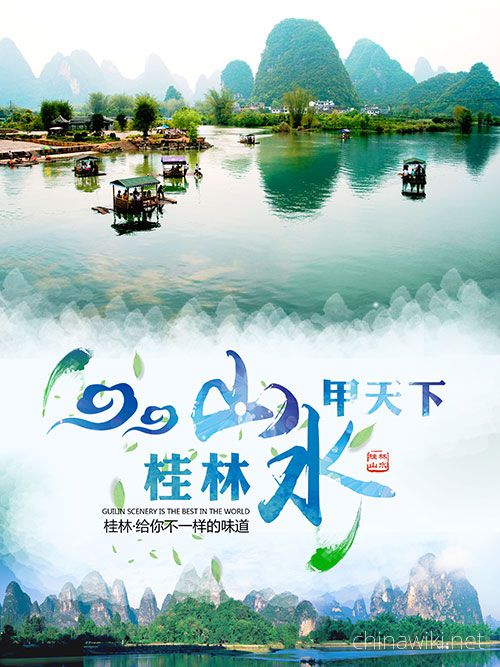
Guilin
Guilin weather
-
1.Shijiazhuang, Hebei Province
Shijiazhuang, Hebei Province - He Bei Sheng Shi Jia Zhuang Shi
Time 2021-03-06 -
2.Daxinganling area of Heilongjiang Province
Daxinganling area of Heilongjiang Province - Hei Long Jiang Sheng Da Xing An Ling Di Qu
Time 2021-03-06 -
3.Putian City, Fujian Province
Putian City, Fujian Province - Fu Jian Sheng Pu Tian Shi
Time 2021-03-06 -
4.Fuzhou City, Jiangxi Province
Fuzhou City, Jiangxi Province - Jiang Xi Sheng Fu Zhou Shi
Time 2021-03-06 -
6.Foshan City, Guangdong Province
Foshan City, Guangdong Province - Guang Dong Sheng Fo Shan Shi
Time 2021-03-06 -
7.Dali Bai Autonomous Prefecture, Yunnan Province
Dali Bai Autonomous Prefecture, Yunnan Province - Yun Nan Sheng Da Li Bai Zu Zi Zhi Zhou
Time 2021-03-06 -
8.Xi'an City, Shaanxi Province
Xi'an City, Shaanxi Province - Shan Xi Sheng Xi An Shi
Time 2021-03-06 -
9.Hanzhong City, Shaanxi Province
Hanzhong City, Shaanxi Province - Shan Xi Sheng Han Zhong Shi
Time 2021-03-06 -
10.Ankang City, Shaanxi Province
Ankang City, Shaanxi Province - Shan Xi Sheng An Kang Shi
Time 2021-03-06 -
11.Qingyang City, Gansu Province
Qingyang City, Gansu Province - Gan Su Sheng Qing Yang Shi
Time 2021-03-06 -
12.Wuzhong City, Ningxia Hui Autonomous Region
Wuzhong City, Ningxia Hui Autonomous Region - Ning Xia Hui Zu Zi Zhi Qu Wu Zhong Shi
Time 2021-03-06

